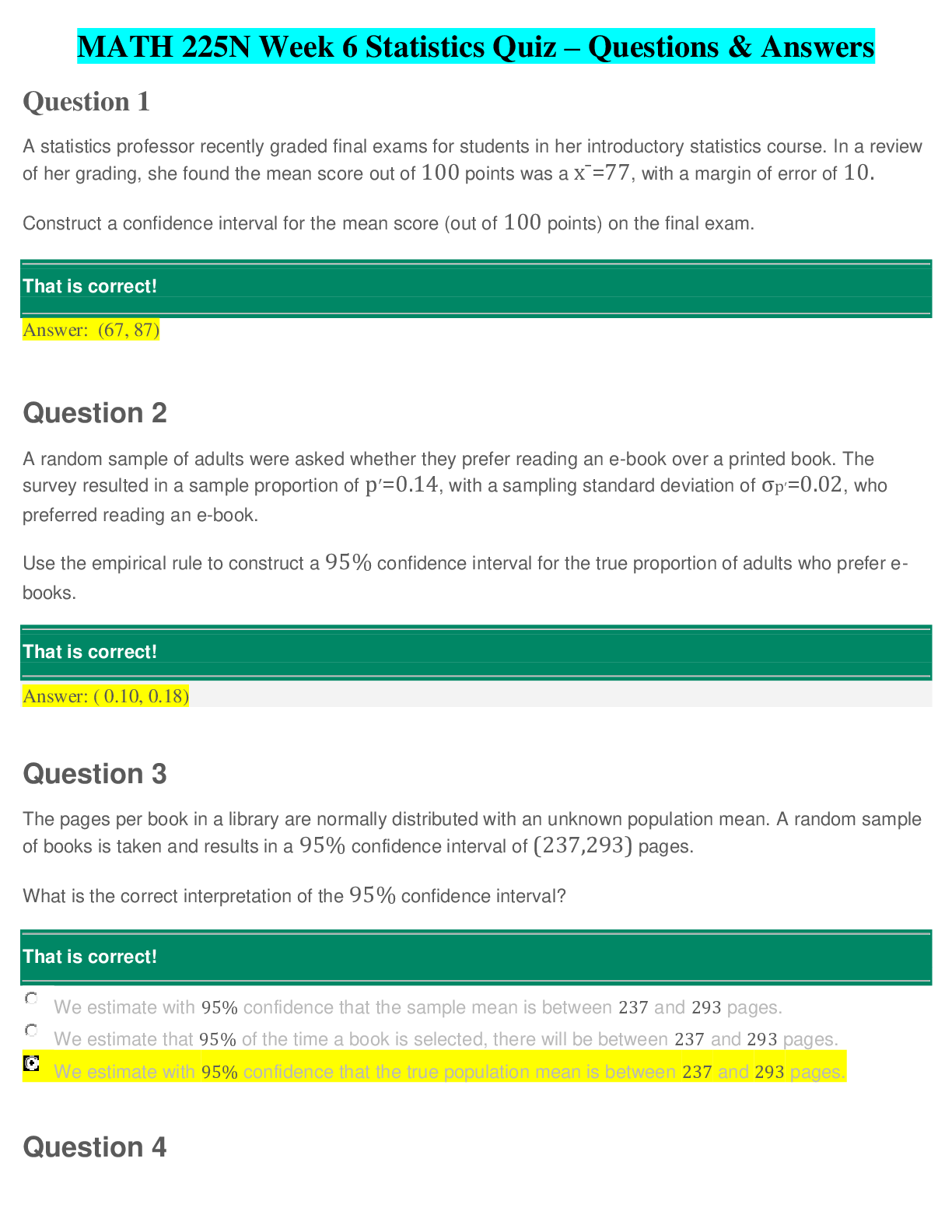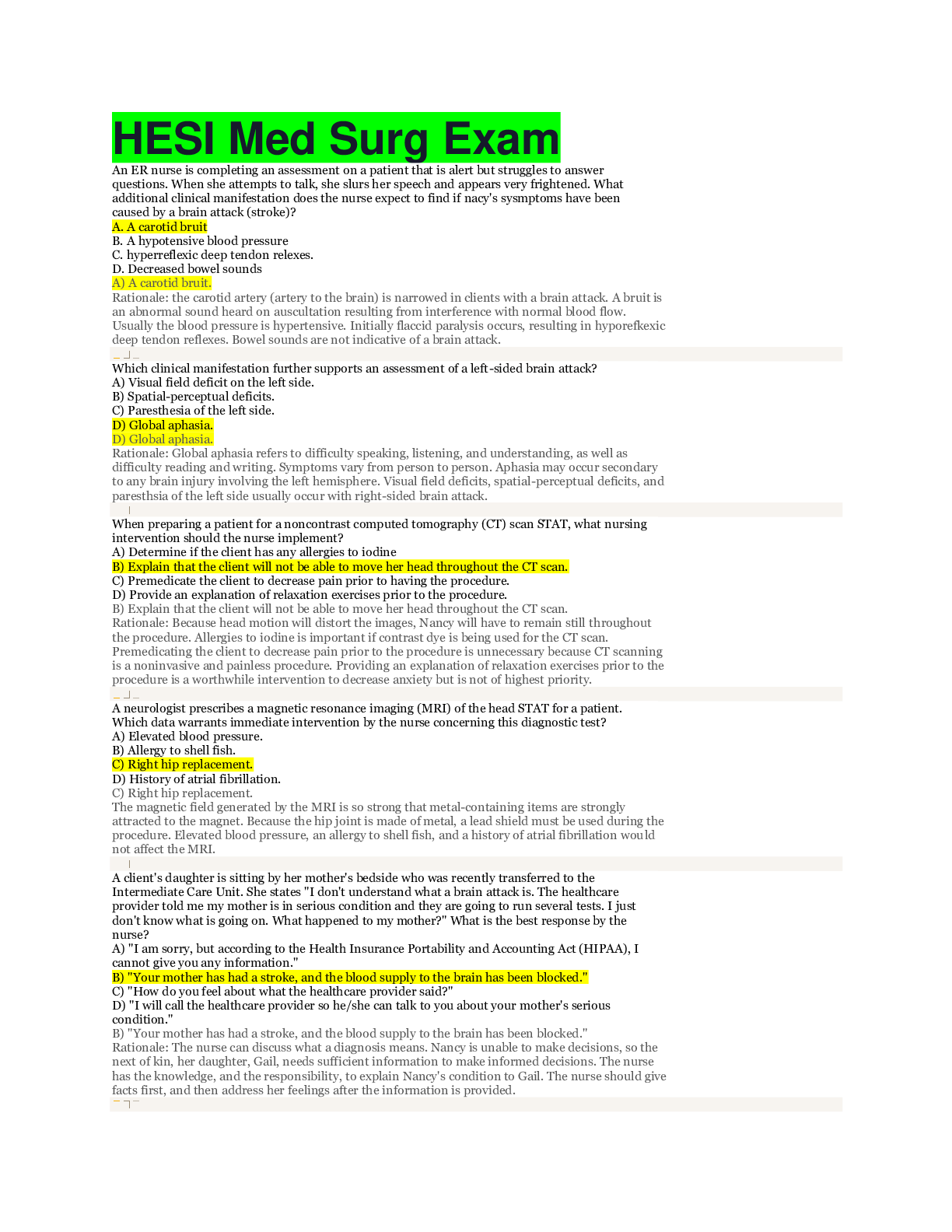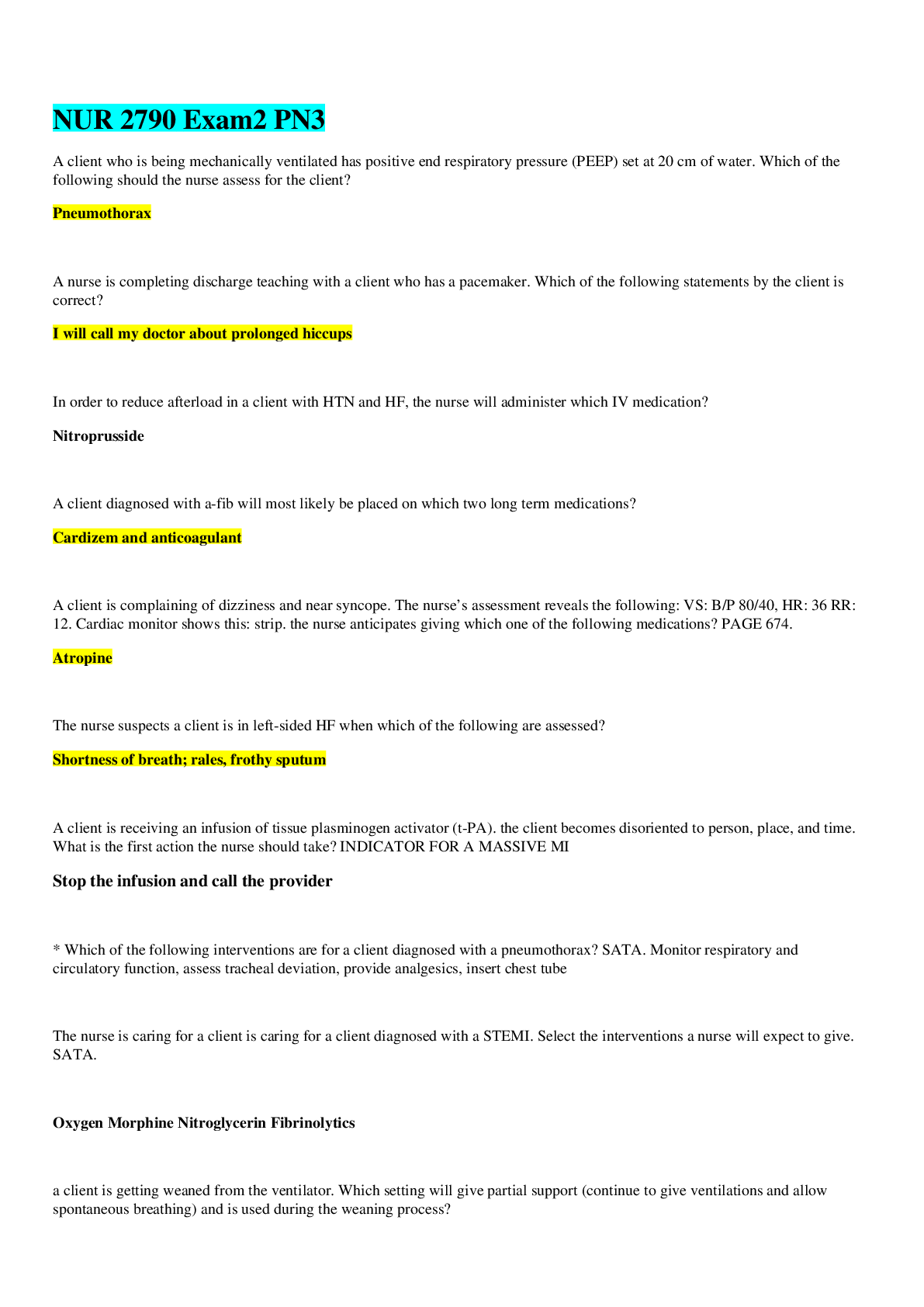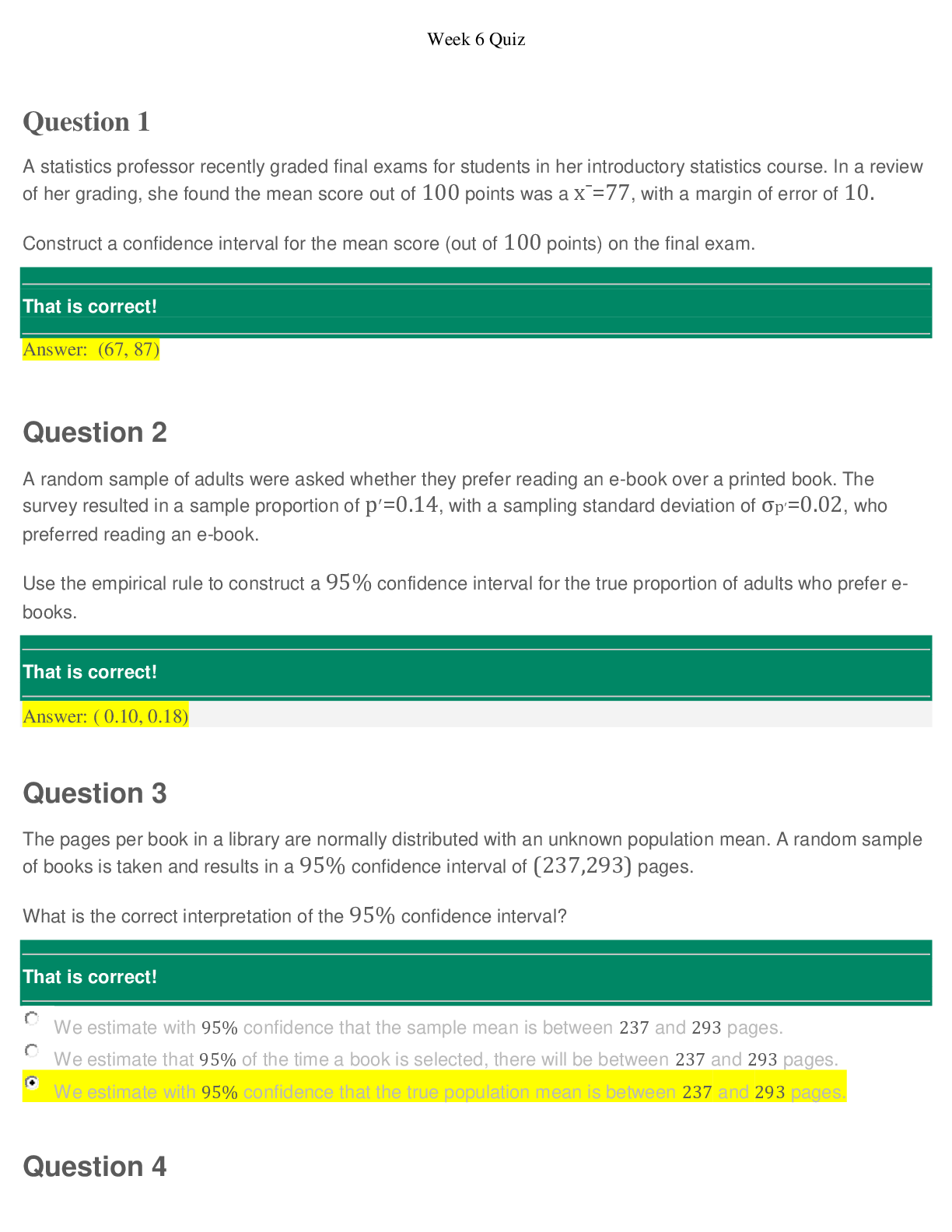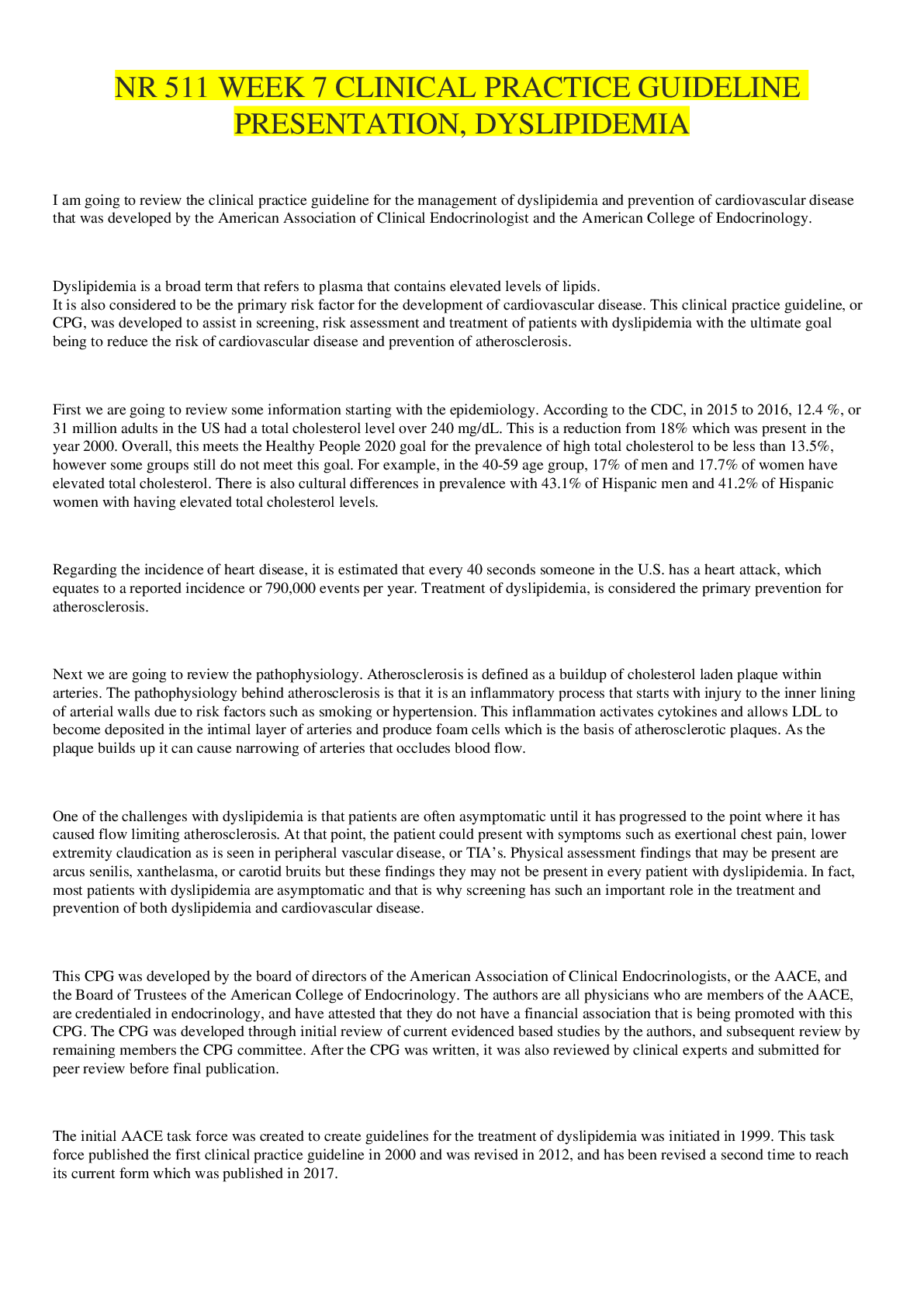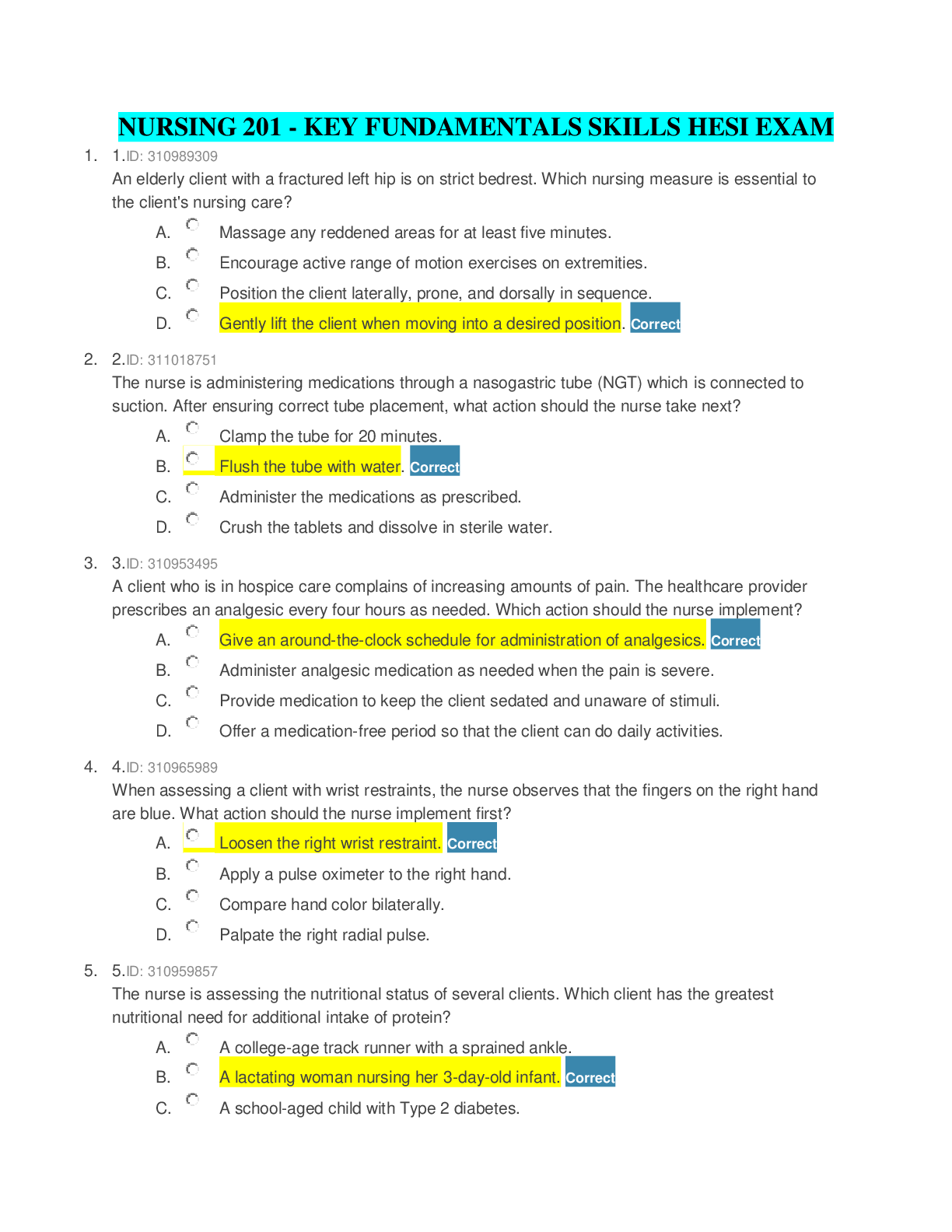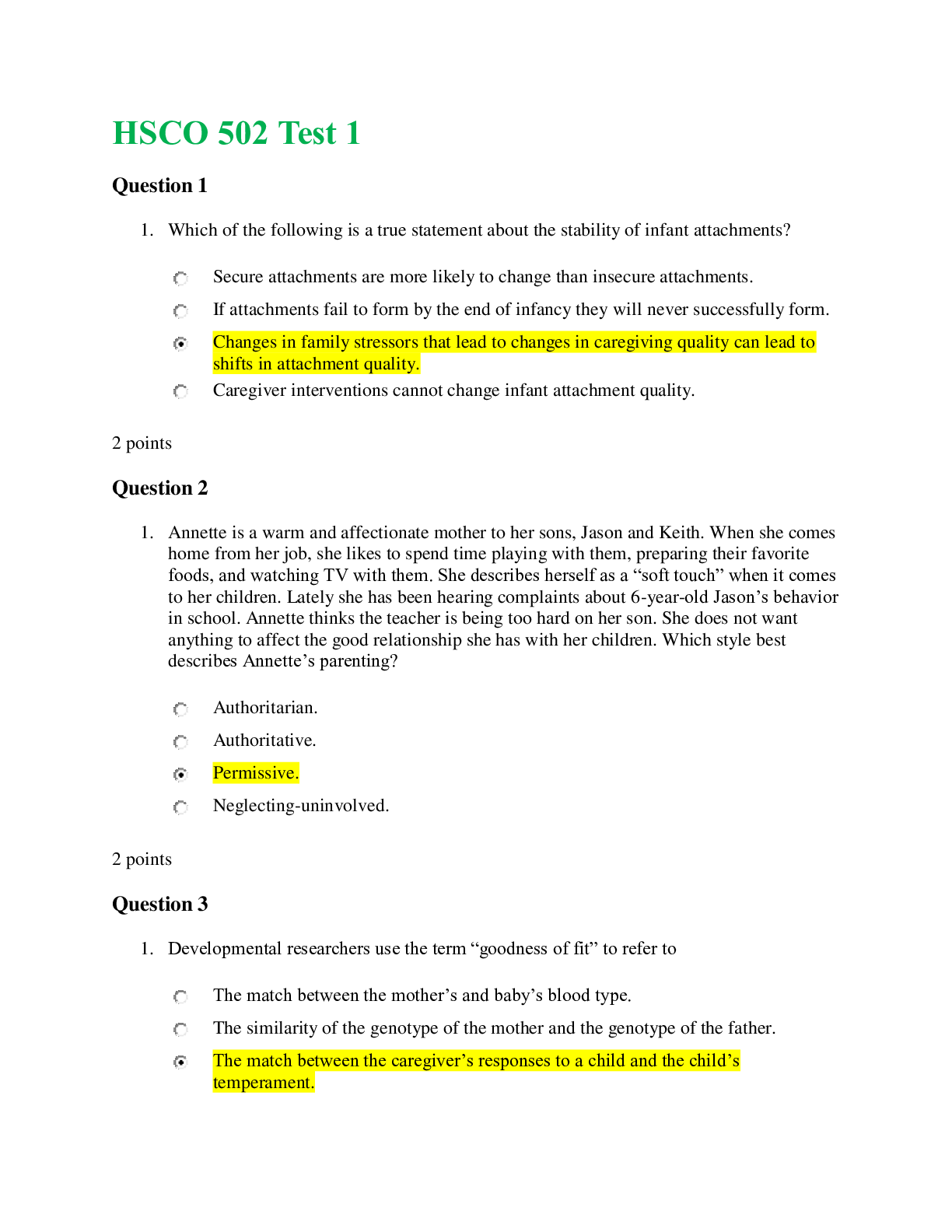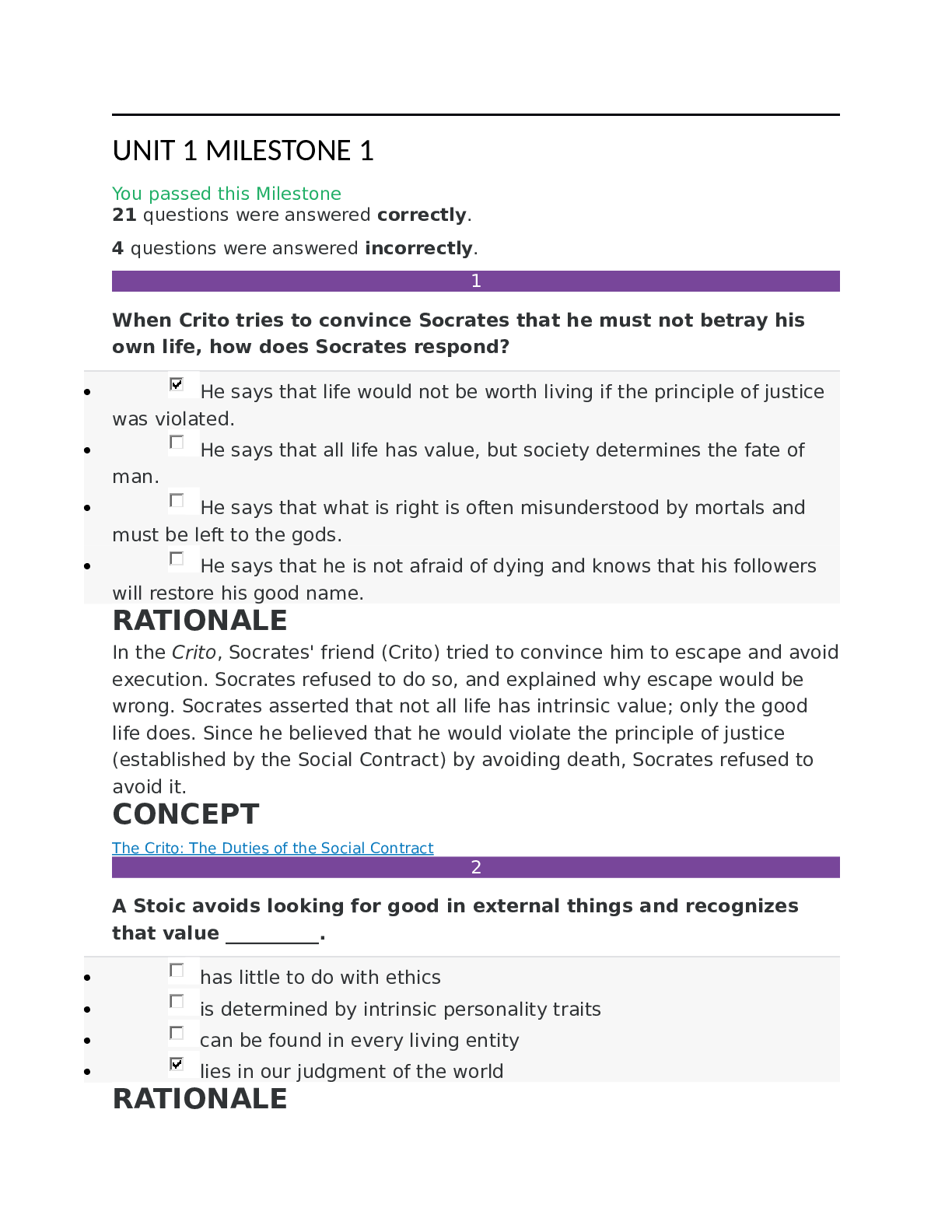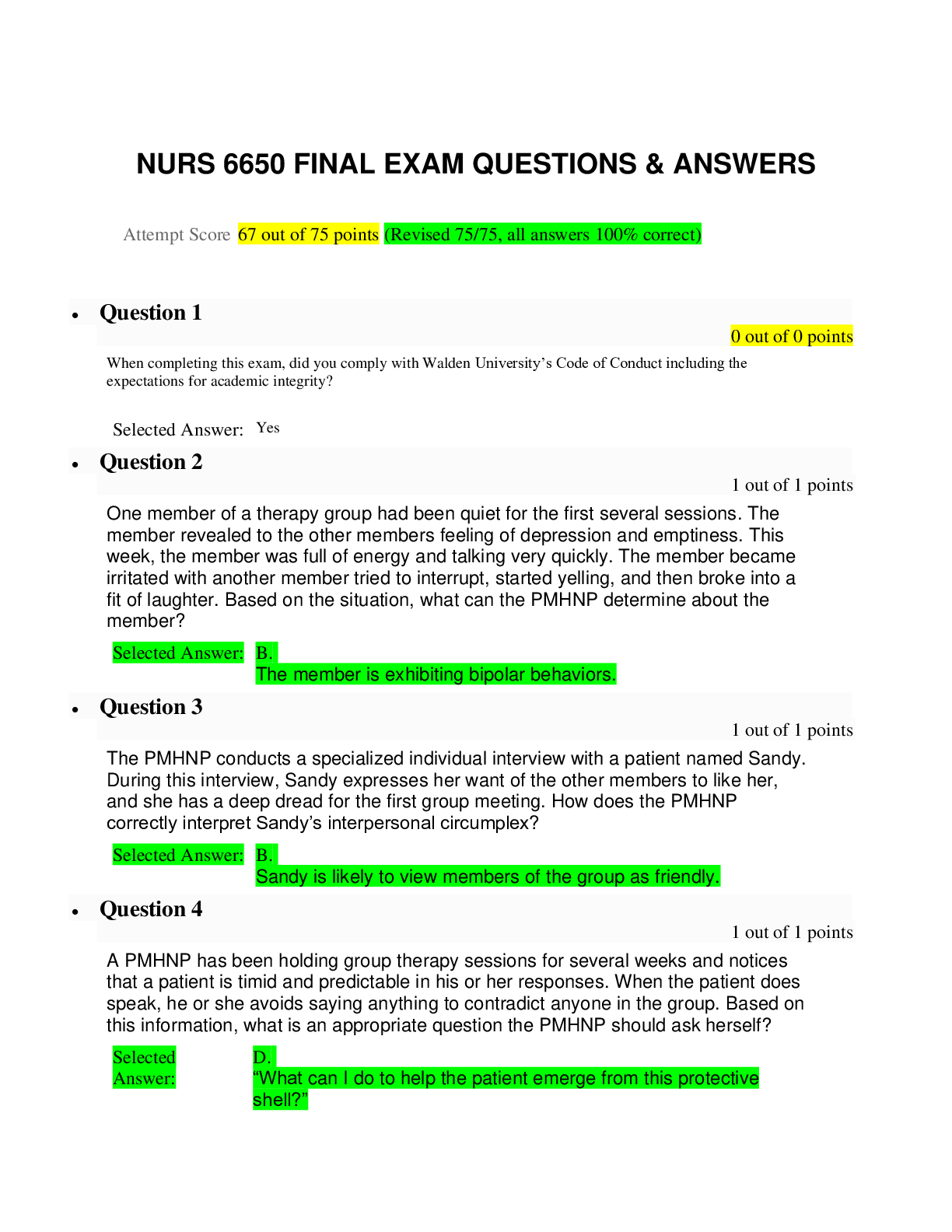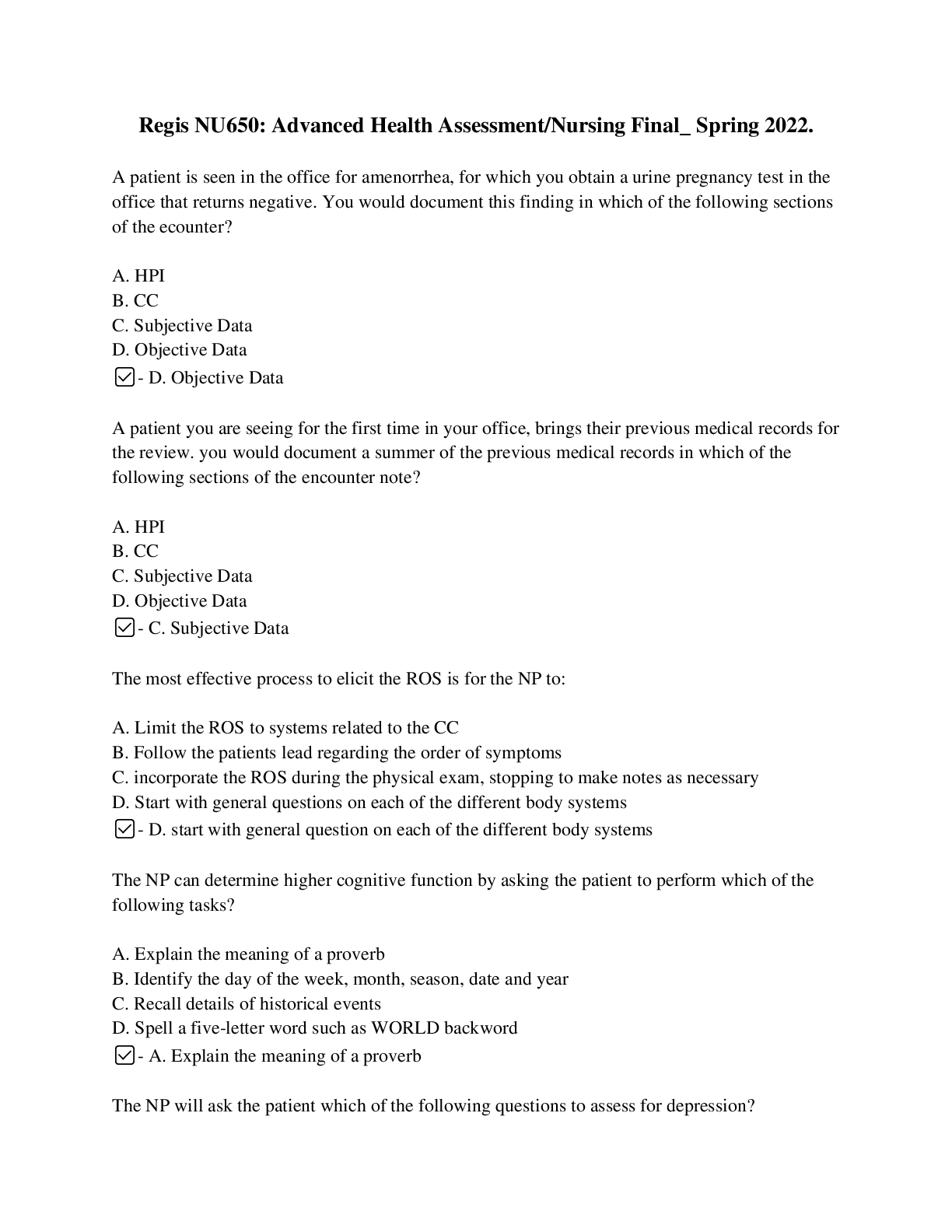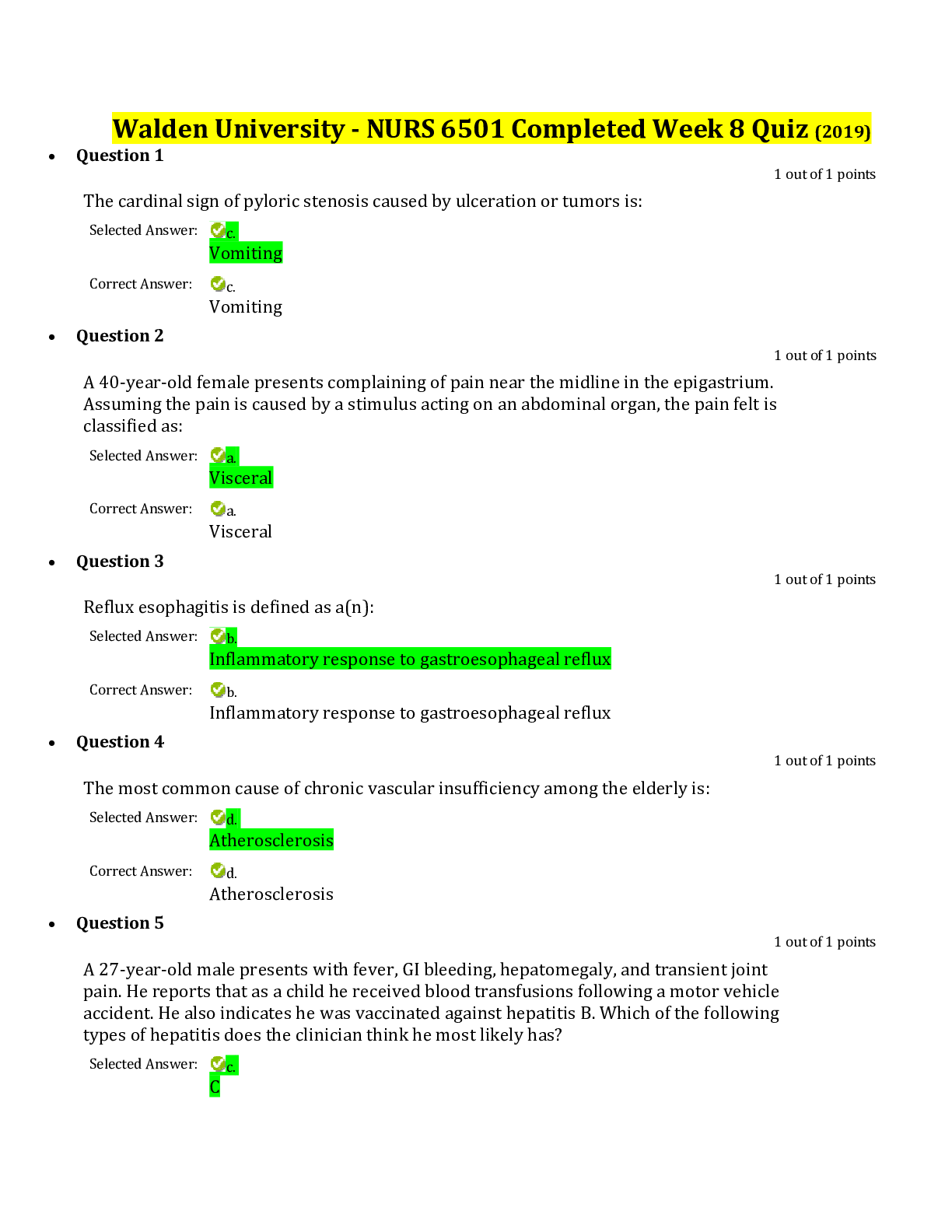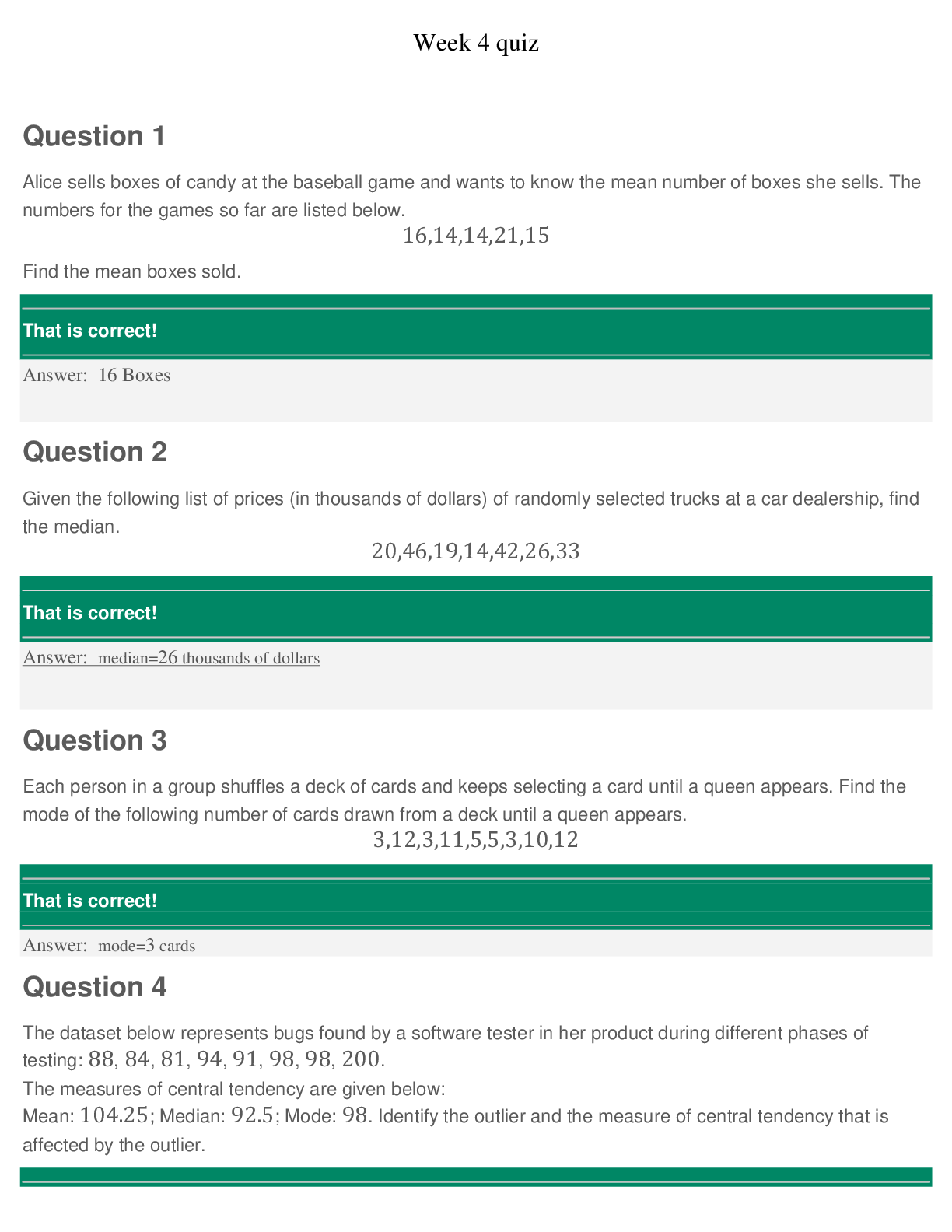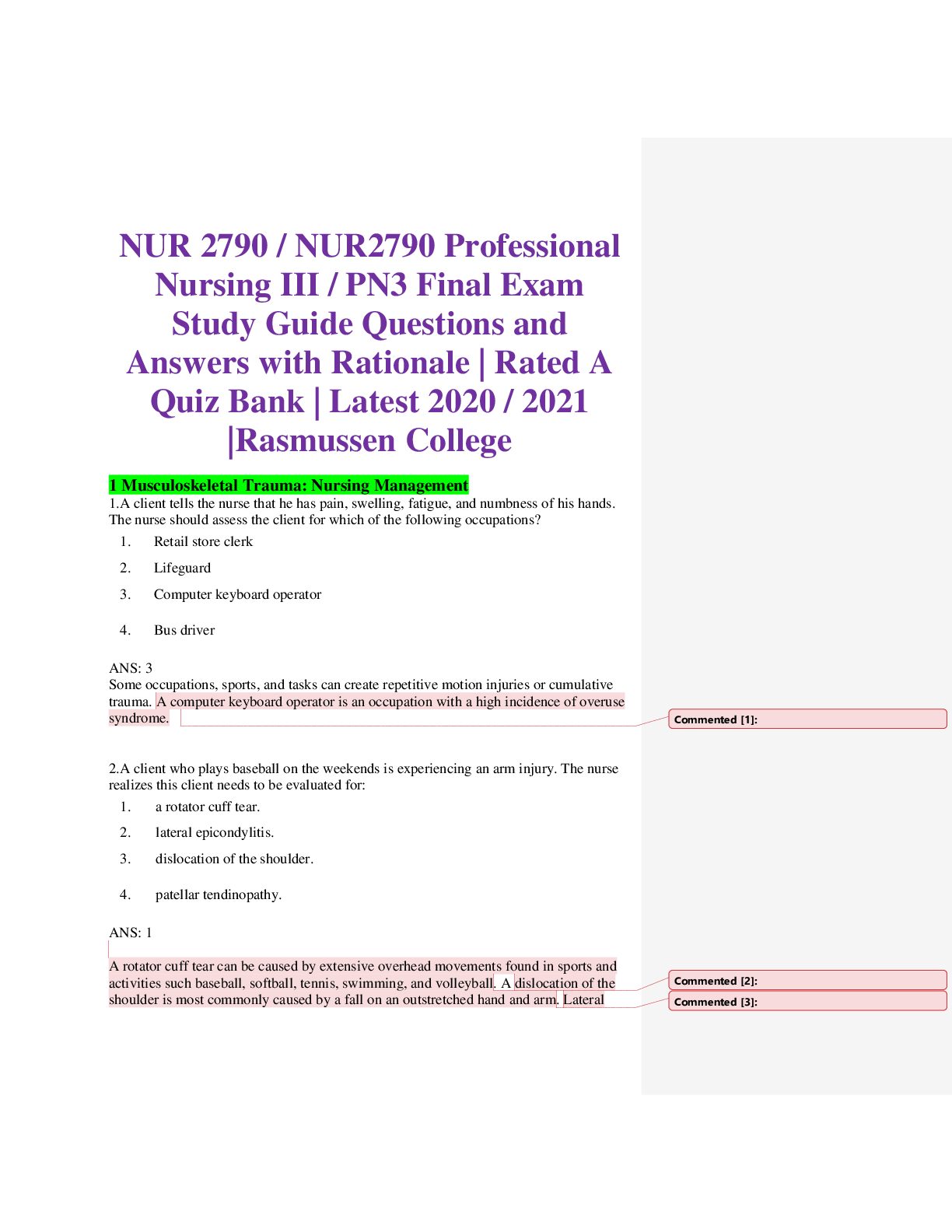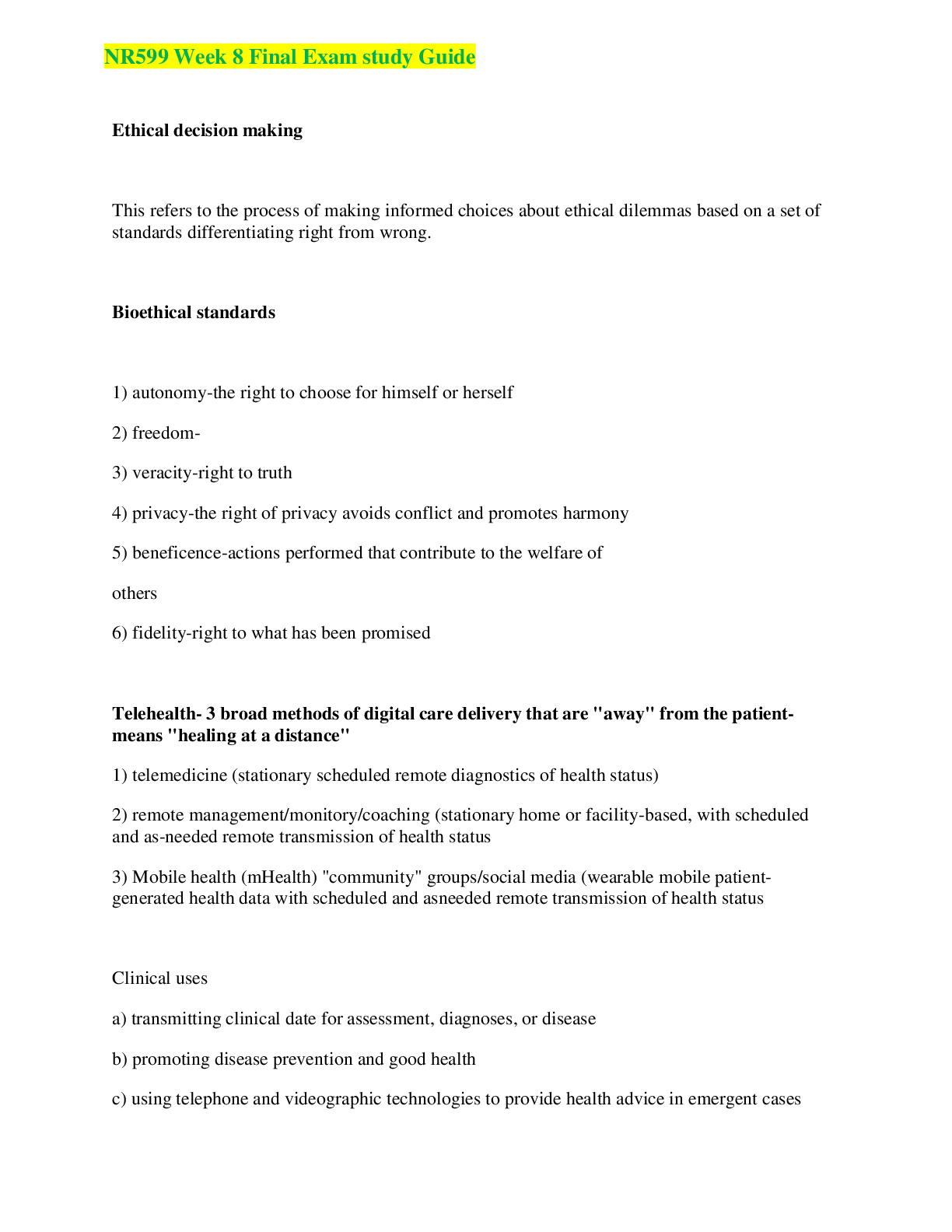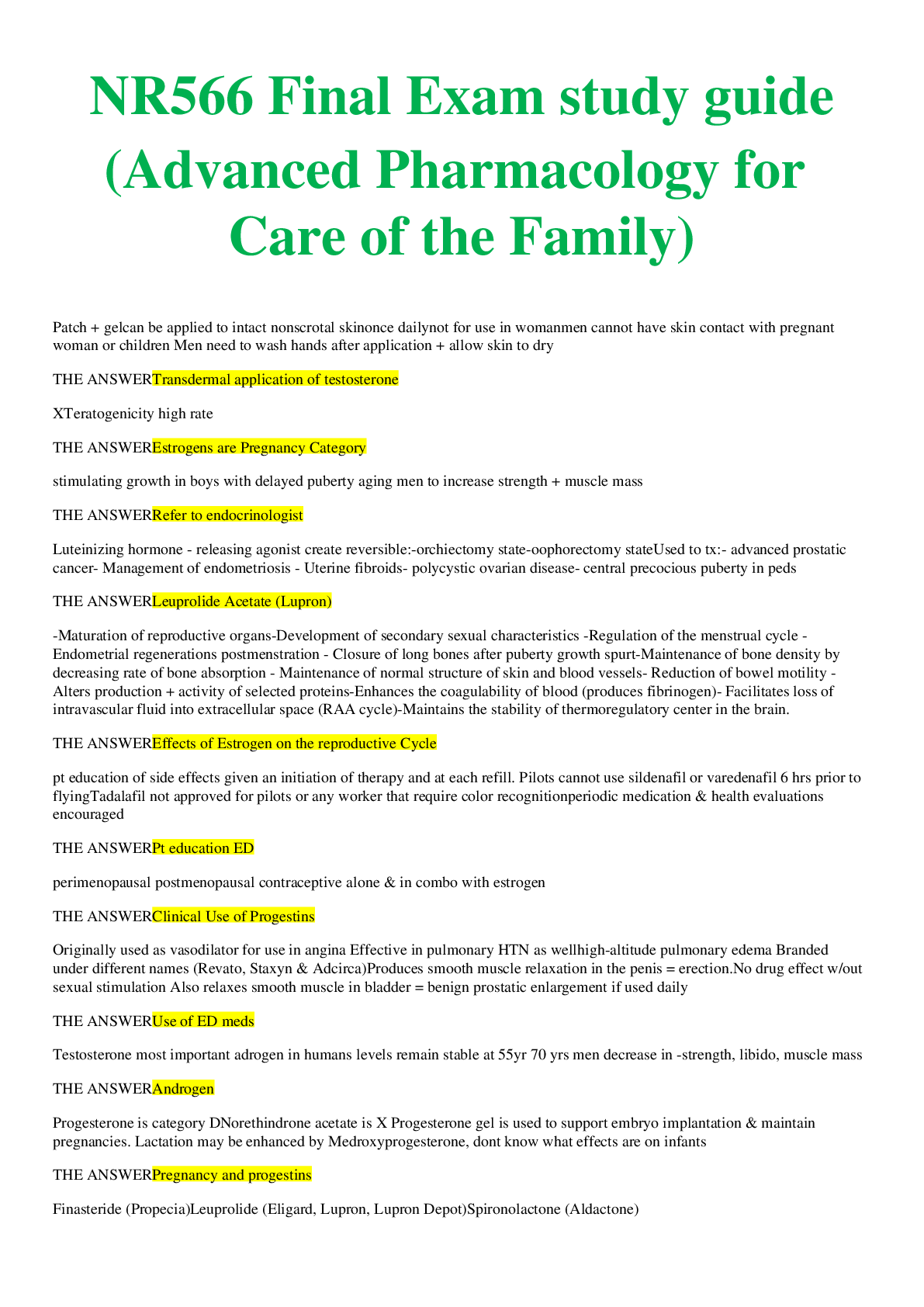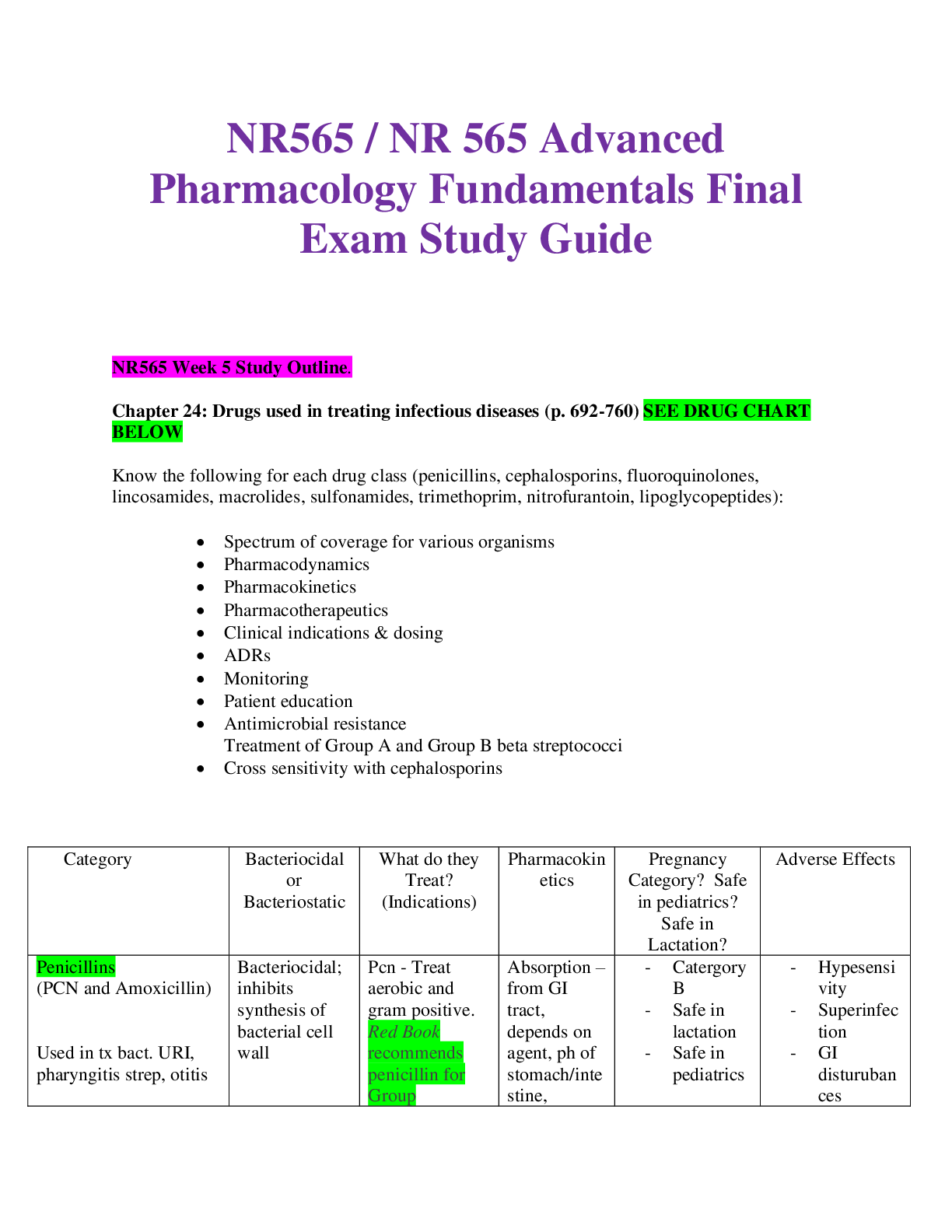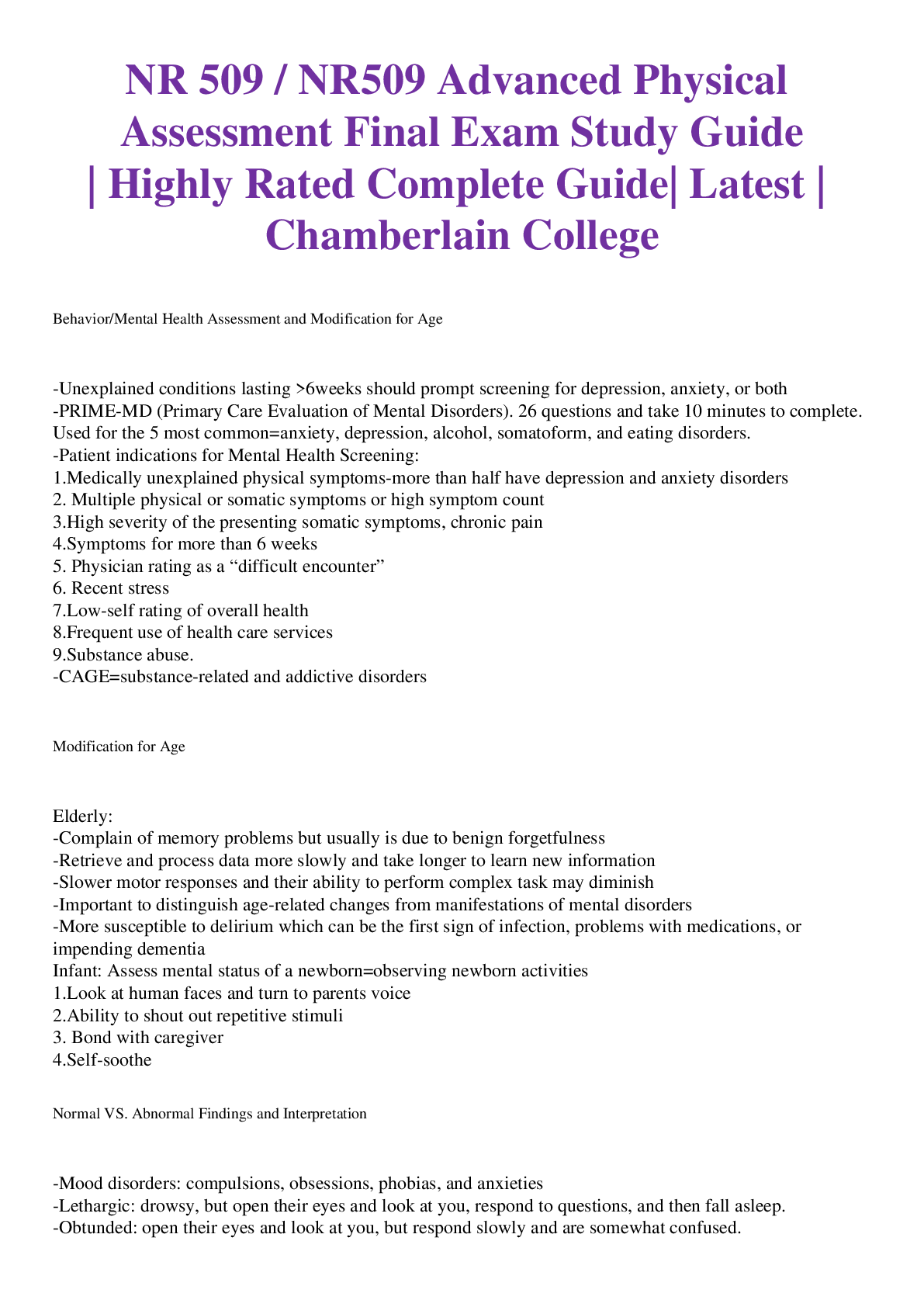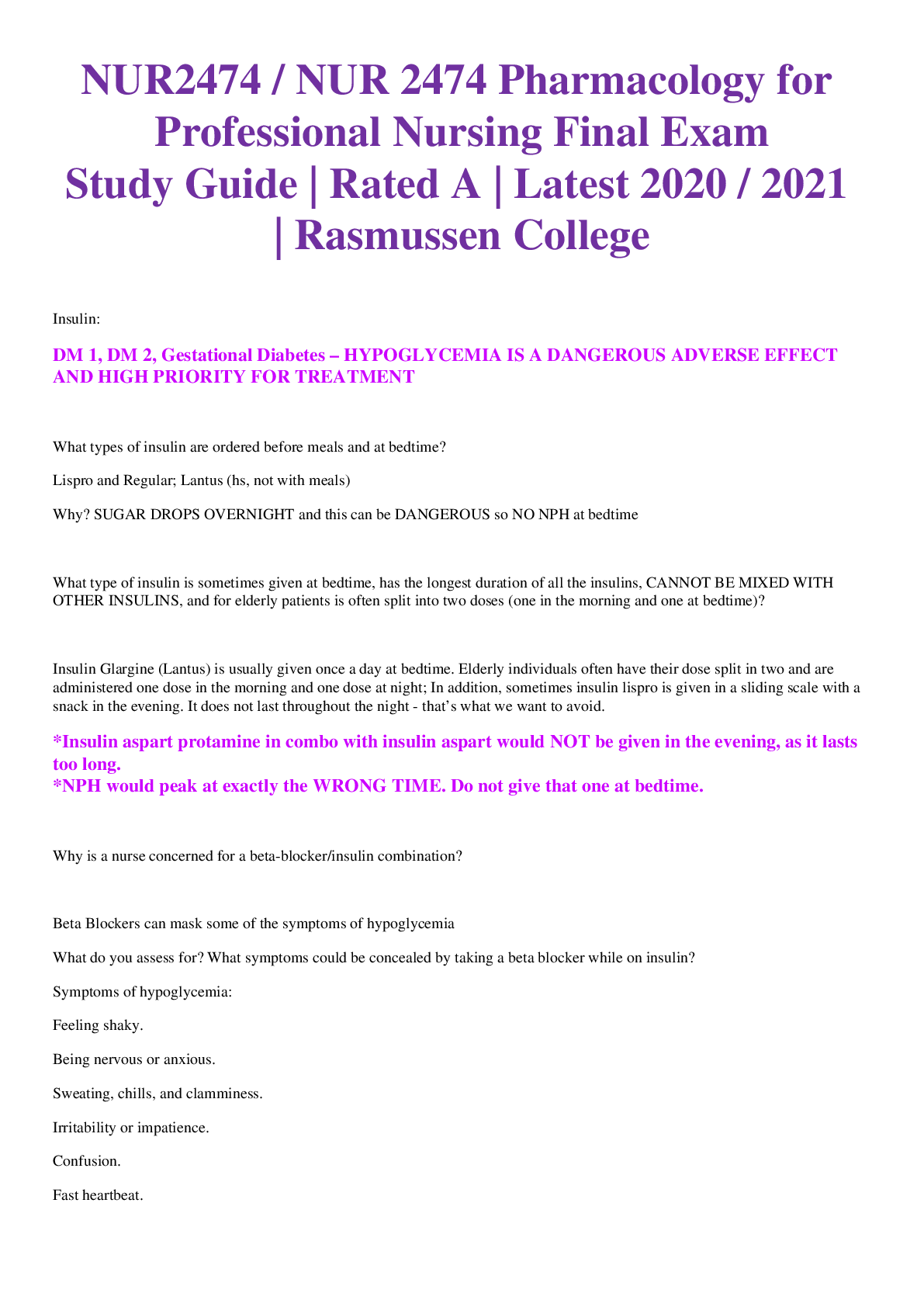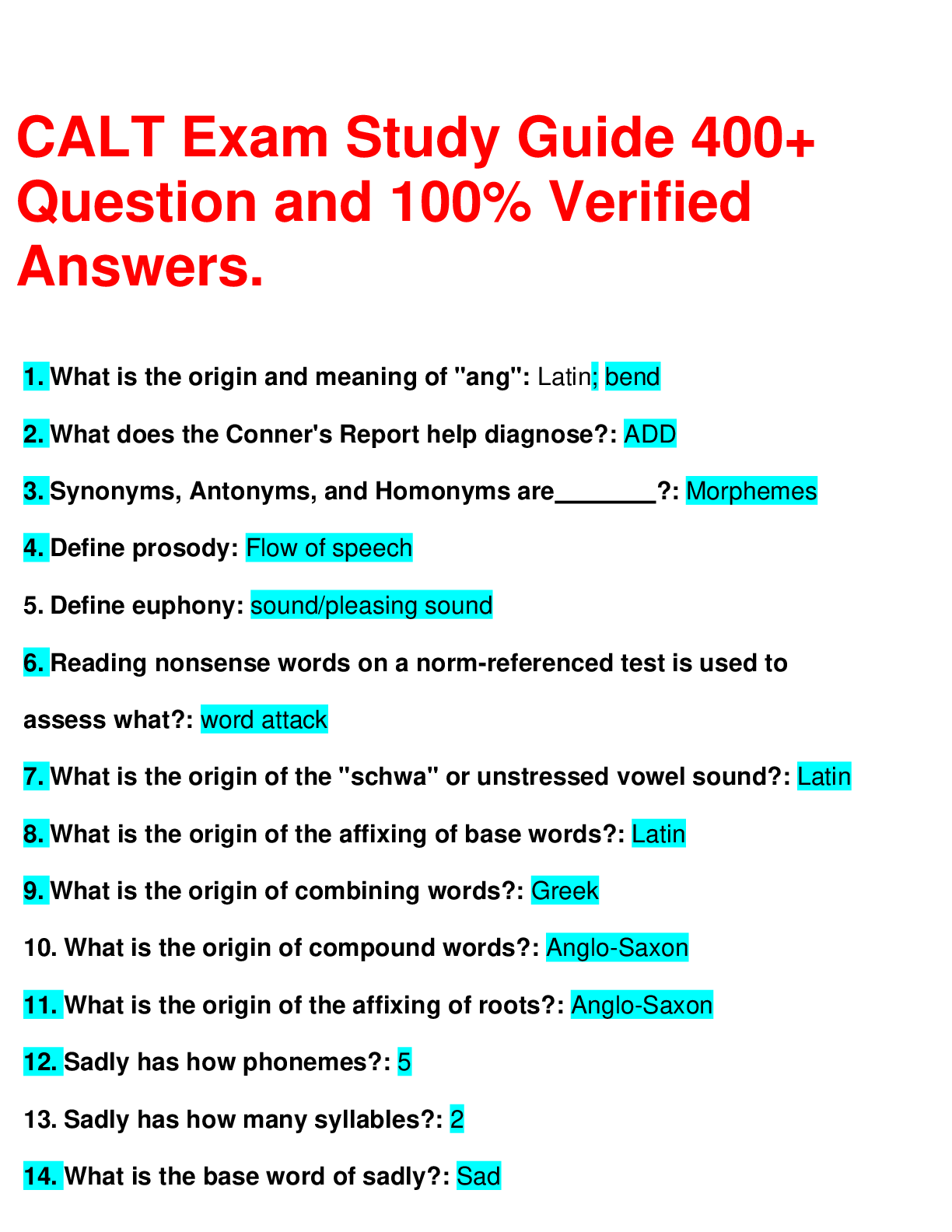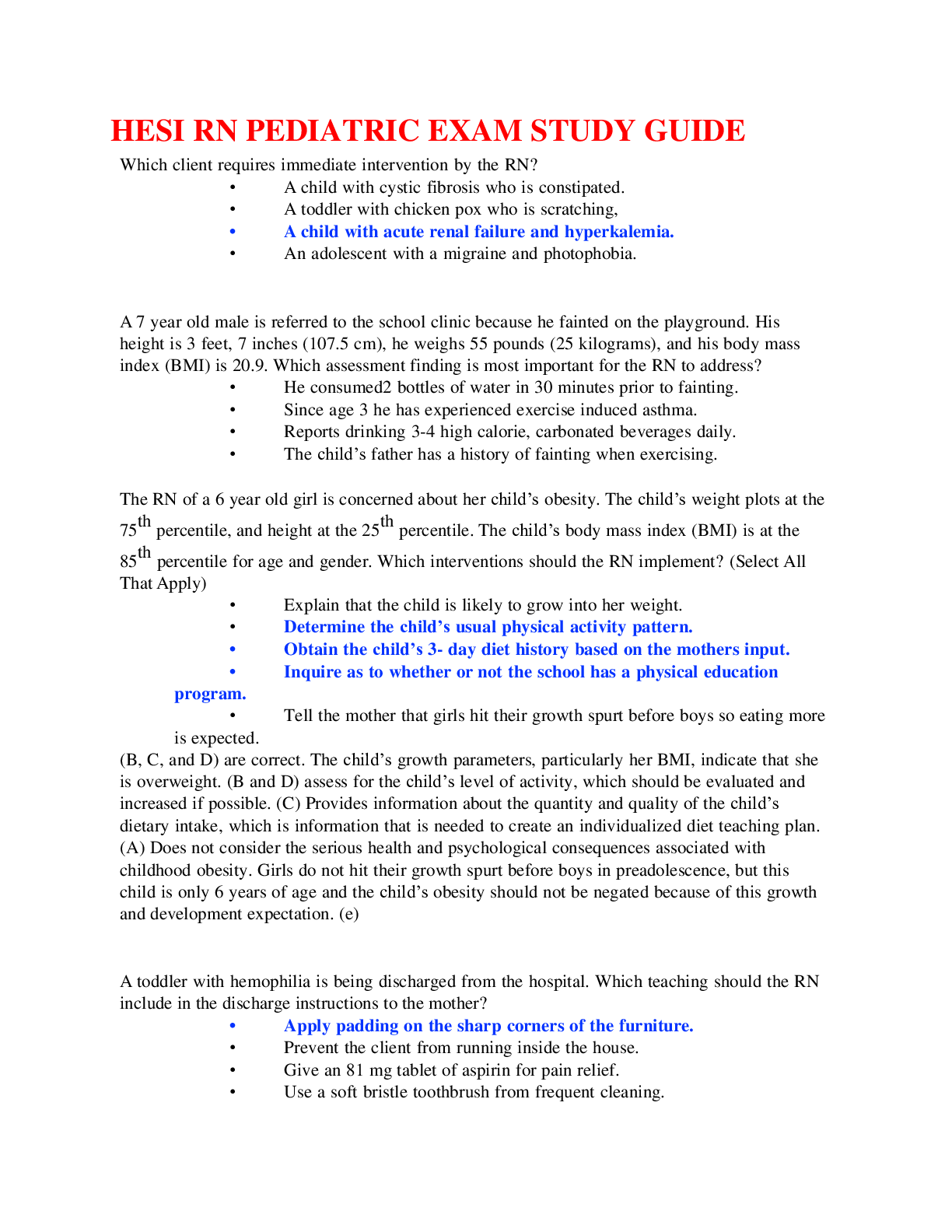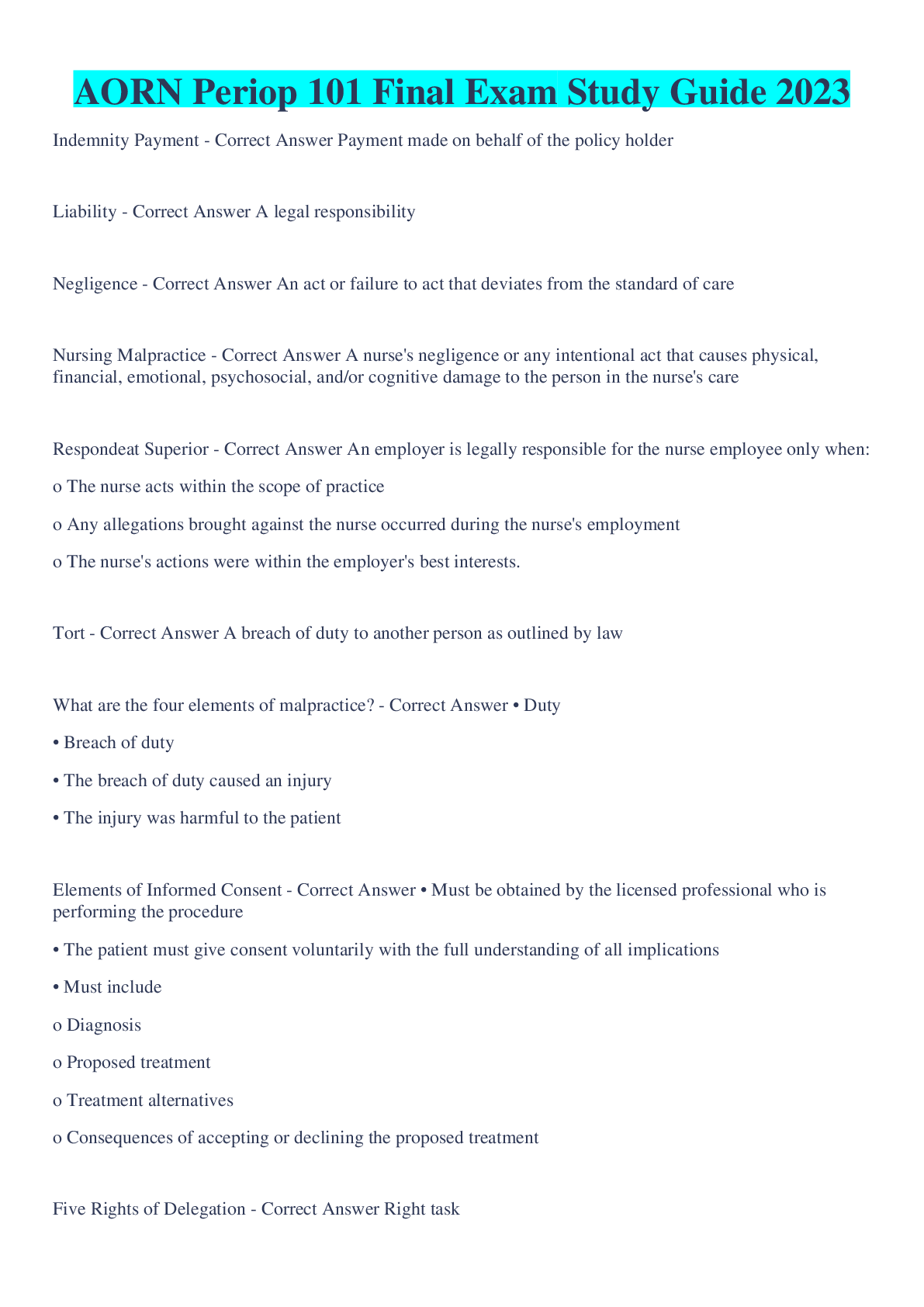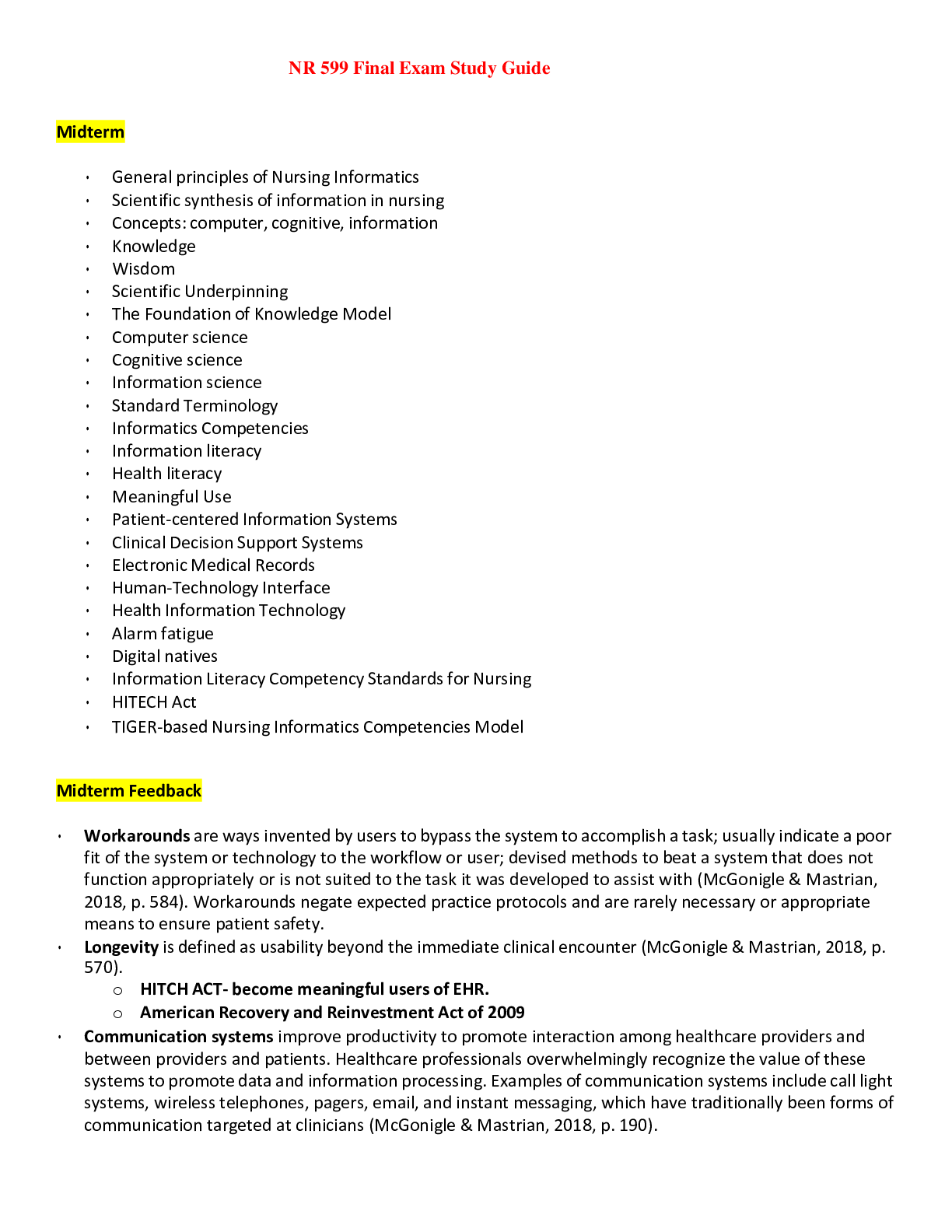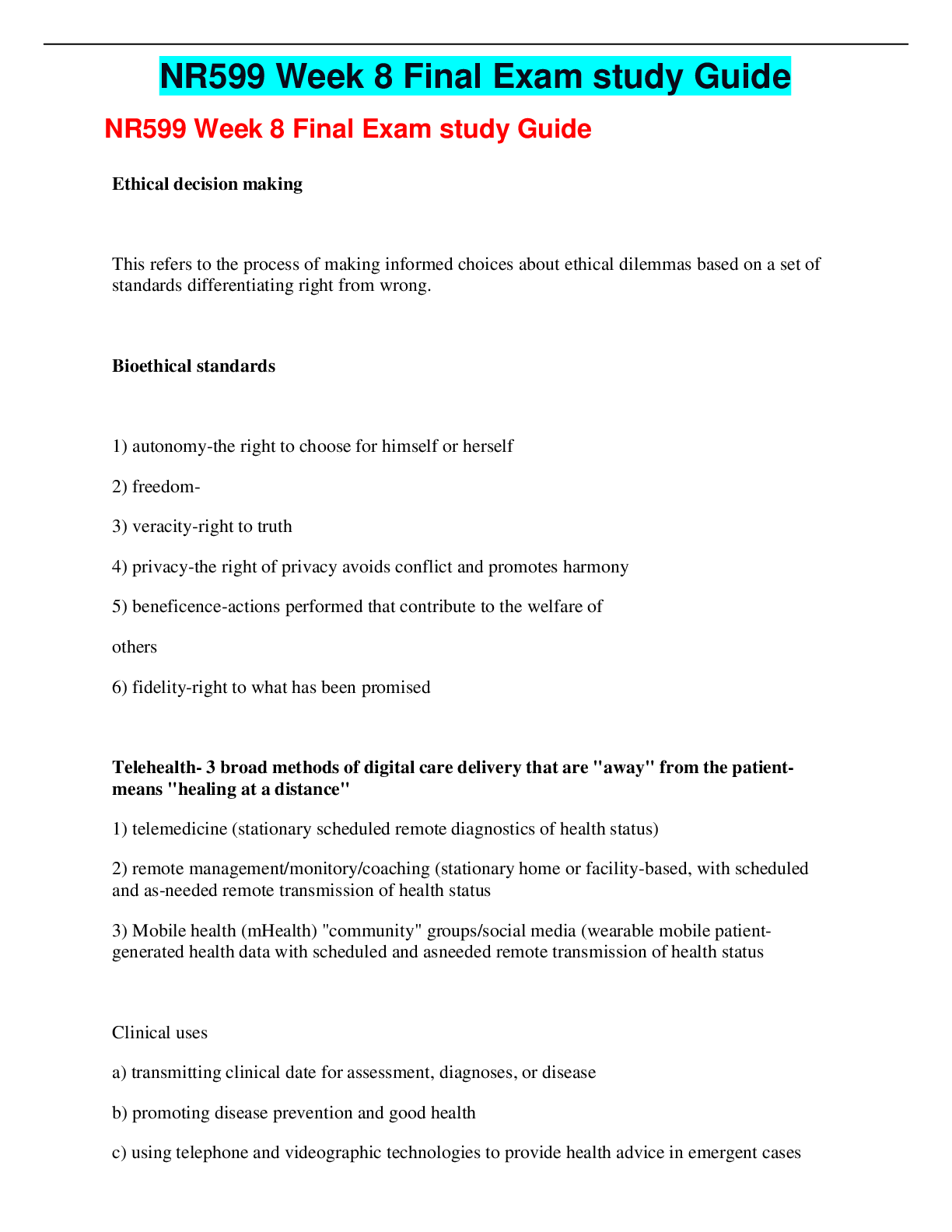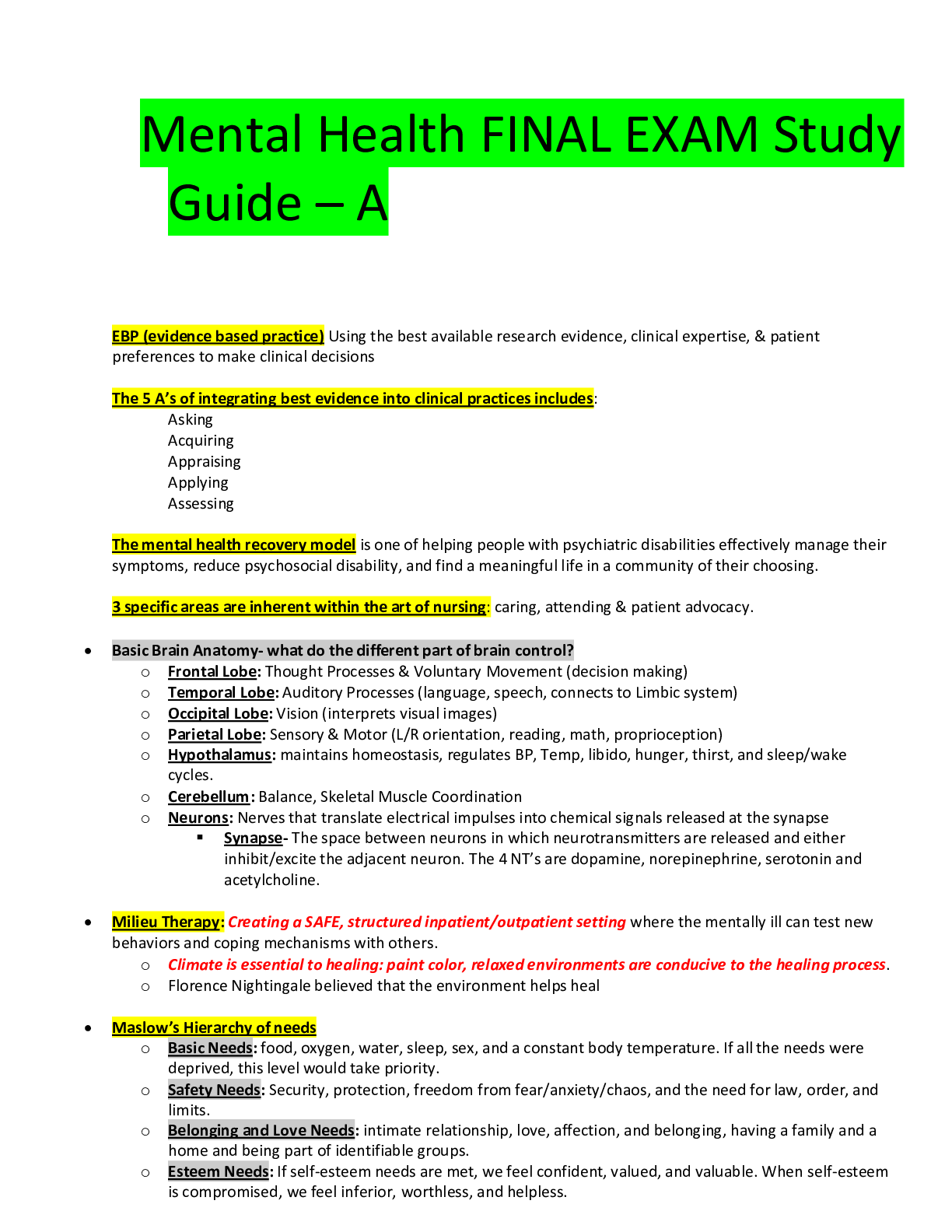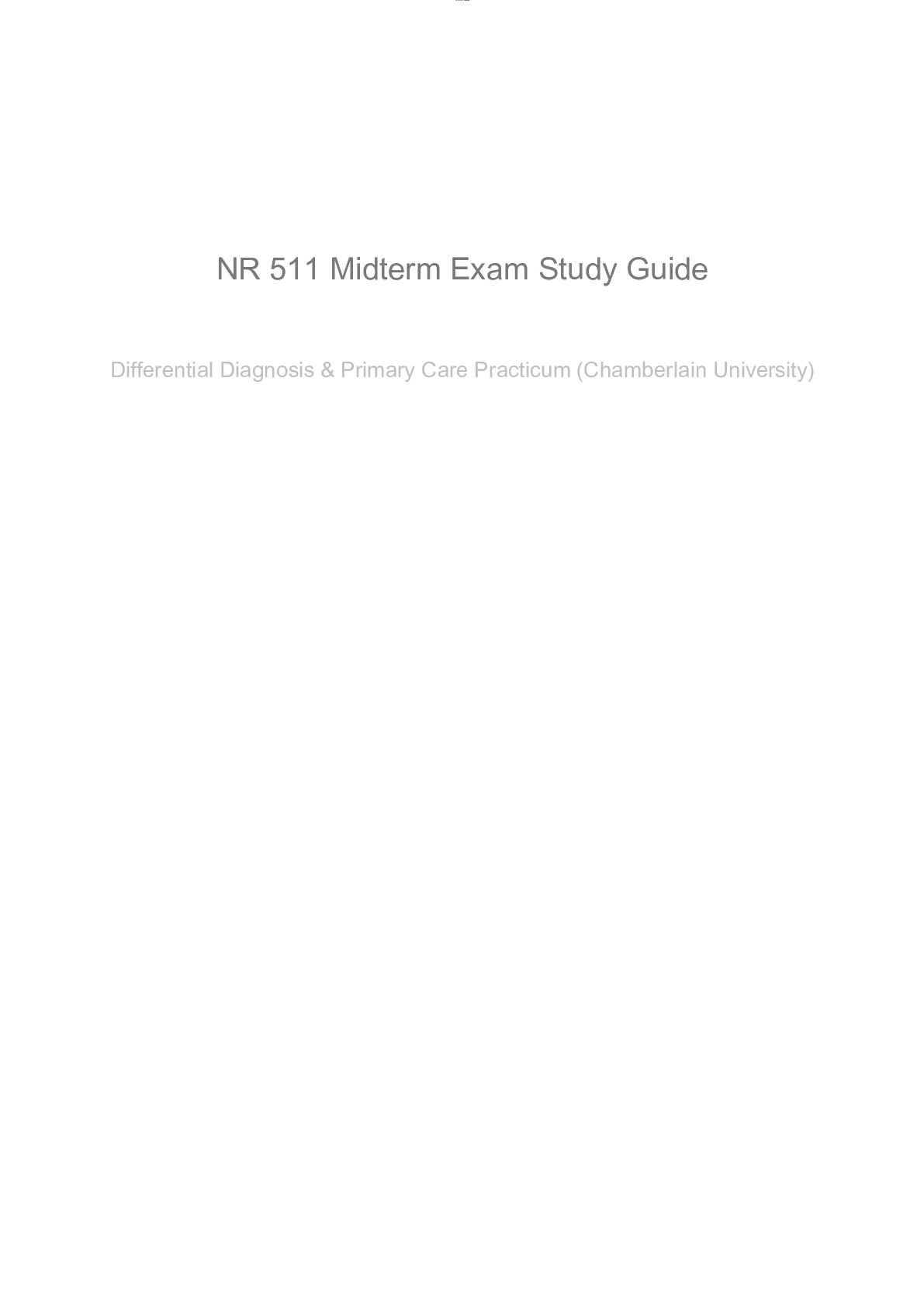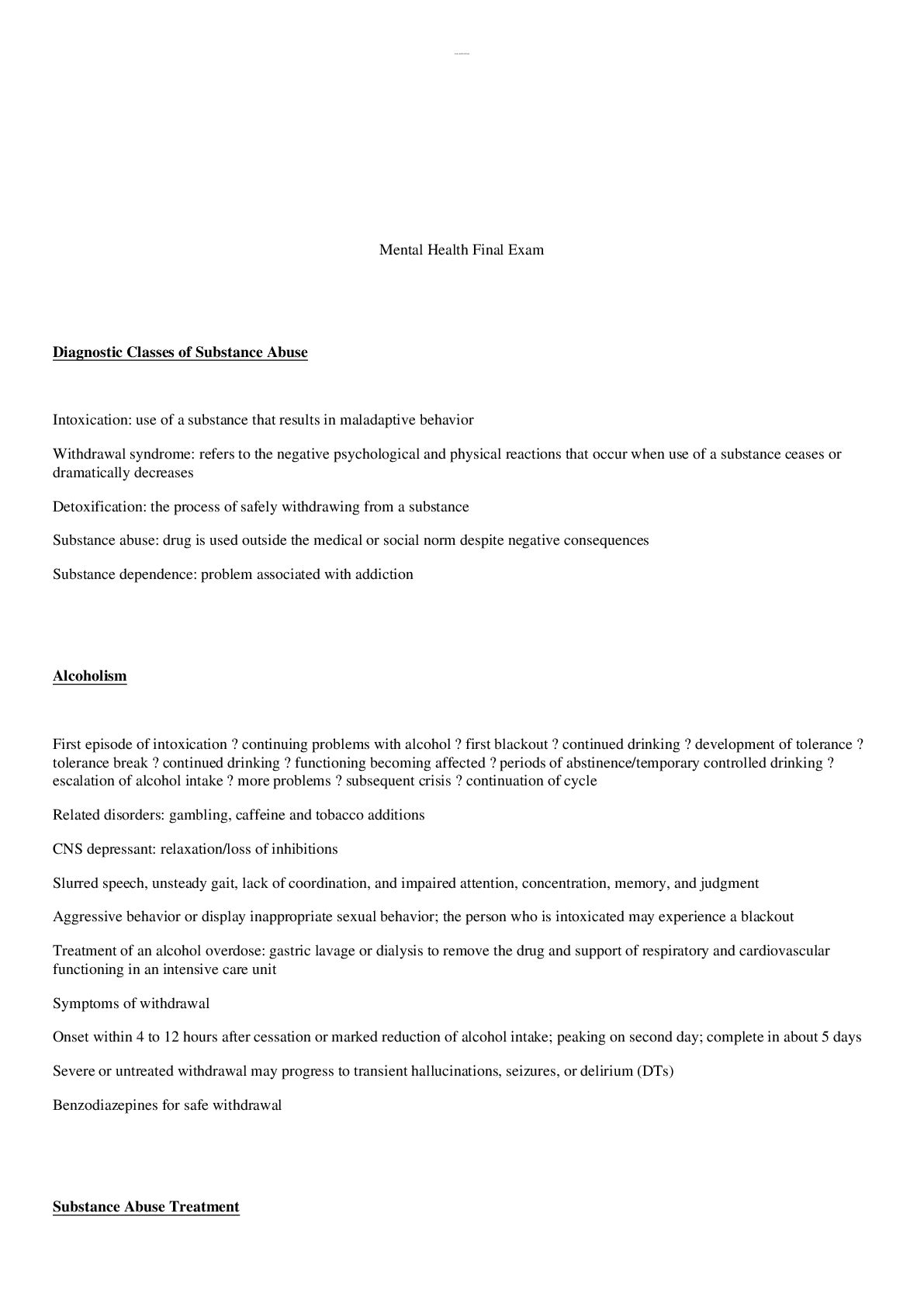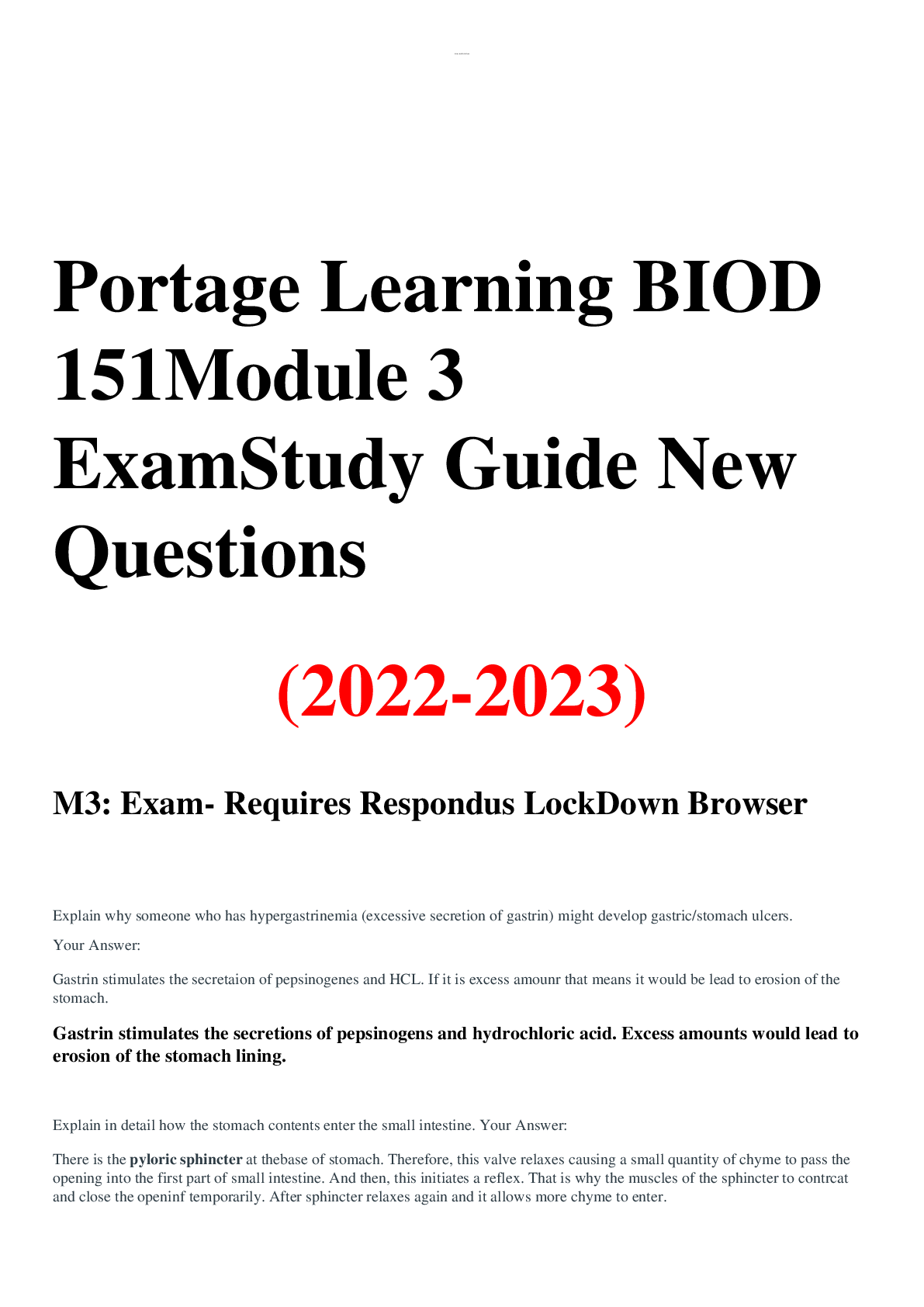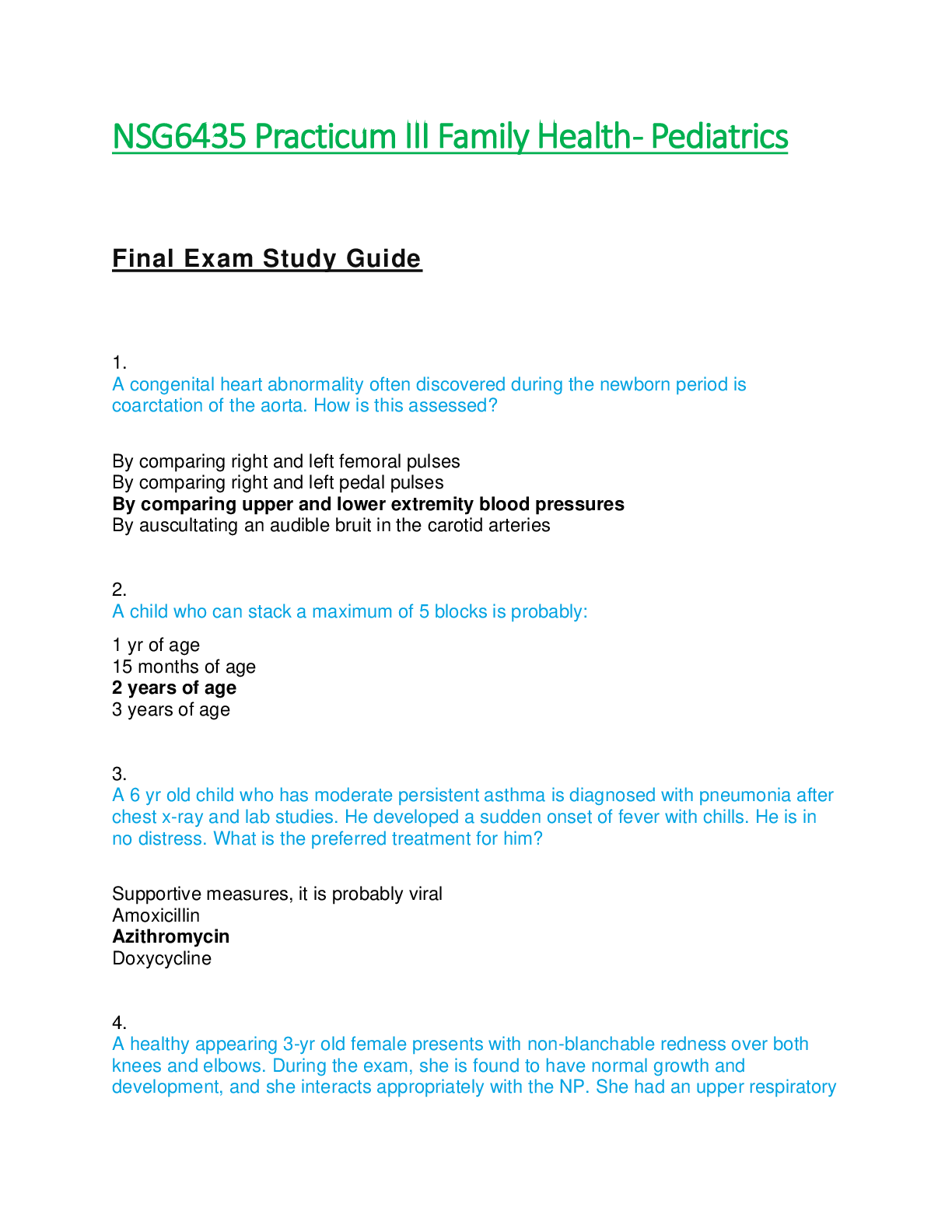*NURSING > EXAM > NSG 6430 - Women's health exam study guide > South University, Savannah - Already Graded A (All)
NSG 6430 - Women's health exam study guide > South University, Savannah - Already Graded A
Document Content and Description Below
NSG 6430 - Women's health exam Latest Guide Already Draded A+ Abnormal uterine bleeding (AUB) has multiple causes. When a woman presents and reports menstrual irregularity with amenorrhea, which i... s the most common cause of amenorrhea? Ectopic pregnancy Adenomyosis Coagulopathy Anovulation • The Tanner scale of sexual maturity rating allows for accurate classification of physical pubertal maturation. During the examination of your patient, you notice that the pubic hair is increased in quantity, is darker, and is present in the typical female triangle but in a smaller quantity. Which of the following Tanner stages does this description meet? Tanner stage I Tanner stage II Tanner stage III Tanner stage IV • A twenty-five-year-old patient presents with urinary frequency and urgency. These symptoms have been occurring for three days without fever. A patient with interstitial cystitis would most likely describe their symptoms as _______. urinary urgency and frequency in the morning and at night pain with urination with scant bleeding terminal dysuria urinary urgency only • The most common cause of chronic pelvic pain for women in the prime of their reproductive years is PID Fibroids Endometriosis Endometritis • A fifty-two-year-old female patient comes in for her annual well-woman examination. Her LMP was fourteen months ago without any breakthrough bleeding. She has also developed some hirsutism. You would document this as __. secondary amenorrhea menopause perimenopause polycystic ovary syndrome (PCOS) • Polycystic ovaries predispose women to a higher incidence of: Adrenal tumors Ovarian cancer Endometrial cancer Endometriosis • A definitive diagnosis of endometriosis cannot be made until which of these is completed? CT scan Transvaginal ultrasound Exploratory laparoscopy MRI • After a thorough history, you note that Marie resides in a community with very high risk factors. These include poverty, violence, and lack of recreational facilities. She tells you that she “hangs out” at a convenience store near the apartment complex she lives at with her mother. “All the group hangs there,” she reports proudly. She shares that she has been menstruating for two years now although she has irregular cycles. She also lets you know that she has had coitus only one time and that he “pulled out.” She does not want to get pregnant, and this is why she is here today. What is your management plan for Marie today? • A well-woman visit for an adolescent should include which of the following? • A seventeen-year-old presents with an appointment for unilateral breast tenderness and swelling. Which of the following would be the most likely etiology for this problem? Breast cancer Mastitis Fibrocystic breast Fibroadenoma • You are completing a pelvic exam on thirty-two-year-old Nancy. You detect a left adnexal mass on the bimanual exam. With an adnexal mass, the practitioner must always suspect ________ until proven otherwise. Pelvic inflammatory disease (PID) Malignancy Pregnancy Polycystic ovary disease X • Majority of urinary tract infections do not require consultation or a referral to a specialist and are routinely treated in primary care practices. Which of the following scenarios would indicate that a consultation or referral is indicated? The presence of secondary sexually transmitted illness A patient with two episodes occurring in one year Patients that remain symptomatic after three days of treatment Patients that show urine human chorionic gonadotropin (HCG) positive • . Long-acting progestins may be used in patients as a contraceptive method. One of the longacting progestins is Depo-Provera. Which of the following best describes the mechanism of action of long-acting progestins in contraception? Decrease in cervical mucus production and thinning of the circle os Thickening of cervical mucus and suppression of gonadotropin levels Increased gonadotropin levels and thinning of the circle os Anovulation caused by increased gonadotropin levels • Iris is a thirty-two-year-old married woman with three children. She comes in for information on using the copper T intrauterine device (IUD) for contraception. Which of the following would be a contraindication to using this appliance? Prior ectopic pregnancy • TeYou are counseling an eleven-year-old girl, Amanda, and her mother about human papillomavirus vaccine (HPV), Gardasil. Amanda is Tanner stage IV at this visit. In counseling this family, you tell them that HPV vaccine ______. is a series of three doses, six months apart will protect Amanda from all strains of HPV can cause seizures in some children is not indicated in her age group as she is not yet sexually active • Urinary tract infections are commonly seen in primary care. A twenty-five-year-old female presents with a new onset of dysuria and suprapubic pain for the last twenty-four hours. The examination reveals only mild tenderness without any peritoneal signs on the lower abdomen. A urinalysis reveals the presence of WBCs. The urine is sent for a culture and sensitivity. In addition to Escherichia coli one might typically expect to see the presence of which bacterium? Klebsiella Staphylococcus aureus Staphylococcus saprophyticus Pseudomonas • Which of the following conditions is not an absolute contraindication to estrogen-containing contraception? Migraine headaches Hypercoagulable state Thromboembolism History of coronary artery diseaseDefinition • Natasha is an eleven-year-old girl brought to your office for an annual well-child visit. When discussing the onset of puberty with Natasha and her mother, you would emphasize which of the following? Breast buds develop before pubic hair. Breast development delayed beyond twelve years of age may be considered pathological. The average age of menarche is nine years. It usually takes about three and half years to go from breast buds to menarche. • A woman is experiencing a milky white nipple discharge. Galactorrhea is usually a finding with which other diagnosis? Fibrocystic breast disease Mastalgia Hyperprolactinemia Breast cancer • You are completing a pelvic exam on thirty-two-year-old Nancy. You detect a left adnexal mass on the bimanual exam. With an adnexal mass, the practitioner must always suspect ________ until proven otherwise. Pelvic inflammatory disease (PID) Malignancy Pregnancy Polycystic ovary disease X A nurse practitioner is educating a patient who has just been diagnosed with polycystic ovary syndrome (PCOS). She needs to be aware that PCOS is associated with which of the following clinical manifestations? Excessive menstrual flow Dry, flaking skin Obesity Hair loss Anticholinergic medications are a type of treatment for which type of incontinence? Urge incontinence sixty-five-year-old obese female with type II diabetes mellitus presents to your office with a complaint of vaginal itching and burning for two weeks. She has not been sexually active for five years. She has tried douching with an OTC cream with no relief. On physical examination, the vulva is deep red with some thick white adherent material. Which of the following conditions would be the most likely cause of her symptoms? Herpes simplex Lichen planus Atrophic vaginitis Fungal infection One important principle of antiretroviral therapy is Response to drug therapy is monitored by HIV RNA levels. A thirty-two-year-old woman presents to your practice with a chief complaint of postcoital bleeding. Which of the following would not be included in the initial assessment of this patient? pap Question 100. Question : The World Health Organization (WHO) has determined absolute contraindications to estrogen containing contraceptives. Which of the following is not an absolute contraindication? A twenty-five-year-old patient presents with irregular bleeding after being on oral contraceptives for six months. It is important to rule out which of the following? practitioner instructor is reviewing the anatomy of the external genitalia. At the opening of the vagina are the Bartholin's glands. Which of the following describes the function of these glands? There are several phases to the menstrual cycle. What phase begins with menses cessation and ends with ovulation? The most common cause of pelvic pain can be noted as endometriosis. But you also know that the most acute causes of pelvic pain are probably A nurse practitioner is participating in a sexual education class for children in middle school. Which of the following is important to review as a nonprotective factor against repeat adolescent pregnancy? A teenage patient presents with amenorrhea and normal secondary sex characteristics. A progesterone challenge is ordered. The purpose is to determine the presence of . A thirty-nine-year-old female has just completed a course of Amoxicillin for the treatment of streptococcal pharyngitis. Her LMP was two weeks ago and reports that it was normal for her. On physical examination, there is some erythema of the external genitalia with a small amount of white discharge. The microscopic wet prep examination reveals few clue cells but an abundance of budding hyphae. There are no WBCs present. Considering the differential diagnoses and results of the microscopic examination, which of the following would be the most appropriate treatment? Which of the following is true regarding education of a forty-two-year-old woman diagnosed with uterine myoma? A nurse practitioner is completing a social and medical history of a patient. Which of the following characteristics places her at risk for early menopause? You are performing an annual well visit on a prepubescent female. Which of the following hormonal changes best describes the fluctuations during this time? A twenty-one-year-old patient presents with symptoms of lower urinary tract infection, including dysuria, frequency, and urgency. The urinalysis reveals the presence of leukocytes but is negative for nitrates. This most likely represents . A patient has a prescription that was written for birth control pills that now has progestin added to the estrogen therapy. What would this intervention decrease the risk of? A nurse practitioner is reviewing the chart of a woman who has findings consistent with polycystic ovary syndrome (PCOS).The diagnostic criteria for PCOS include all of the following except: Breast tissue is composed of glandular, fibrous, and fatty tissue and a complex lymphatic system. Where does lymph from the medial cutaneous area of the breast flow? A thirty-three-year-old woman presents to your clinic complaining of a dark brown, watery vaginal discharge and postcoital bleeding. There is a strong history of multiple unprotected sexual encounters. Which of the following findings on examination would be suspicious for cervical cancer? A fifteen-year-old patient who presents with symptoms consistent with premenstrual syndrome (PMS) is concerned that she may have ovarian cancer. Your best advice to this patient is that PMS is typically caused by which of the following? It is known that a woman who is menopausal has an increased risk of heart disease. Which of the following lipid changes occur with estrogen withdrawal in menopause? Which of the following is an approved treatment for premenstrual dysphoric disorder (PMDD)? A patient has symptoms consistent with Chlamydia. Which laboratory test would aid in the diagnosis? A nurse practitioner is counseling a woman with fibrocystic changes in the breast. Which of the following is not caused by this change? A patient is coming to the clinic for a follow-up of some diagnostic testing that she had done. When you review the chart, you find that she now has findings consistent with a diagnosis of polycystic ovary syndrome (PCOS).You recall that PCOS is characterized by which of the following? A twenty-five-year-old pregnant client presents with a complaint of headaches that are confined to the base of the head as well as the upper neck and feels “tight” in nature. She denies visual changes, photophobia, or nausea. The most likely diagnosis is which type of headache? A nurse practitioner is caring for a woman with primary and secondary amenorrhea. The pelvic exam was normal. Which of the following may be the cause if etiology originates in the hypothalamus? You are examining a twenty-nine-year-old female with a three day history of dysuria and urinary frequency. On examination, the patient has mild abdominal pain with palpation in the umbilical area without rebound tenderness. Her test for cerebrovascular accident (CVA) tenderness is negative. This most likely represents which of the following? A thirty-five-year-old female presents with perimenopausal symptoms. You recall that this may begin during which age group? A woman has been prescribed Depo-Provera injections every three months for contraception. What would be the most likely side effect that she would need to be educated about? A woman has been prescribed Depo-Provera injections every three months for contraception. What would be the most likely side effect that she would need to be educated about? A twenty-four-year-old female presents to the practice with a painless 2 cm, lobular mass in the right breast that is freely mobile and firm. This has been noted on self-breast examination, and she reports it has been unchanged for the past three months. The best course of action by the nurse practitioner would be to . Which of the following choices represents a disorder of the reproductive tract that causes pain, erythema, dyspareunia, and a perineal mass? A twenty-four-year-old female patient has been diagnosed with primary dysmenorrhea. Which of the following medications would be used as a first line to help control her symptoms? Changes in hormonal regulation during menopause result in the gradual cessation of menstruation. From which gland is Androstenedione secreted? A postmenopausal woman is concerned because she is having postcoital bleeding. Which of the following would be the most likely etiology? A fifty-five-year-old woman presents to the clinic for evaluation of a breast mass. Which of the following is not a typical presenting sign of breast cancer? A thirty-two-year-old patient comes in for a workup of infertility. During the history, the nurse practitioner suspects that the patient may be experiencing anovulatory cycles. In order to confirm ovulation, which of the following tests would be most appropriate to order? A seventeen-year-old female patient presents with amenorrhea for four months. She did experience menarche at the age of fifteen but had not had a menstrual cycle since. On physical examination, it is noted that she has normal secondary sexual characteristics. The nurse practitioner will consider a progesterone challenge to determine the presence of adequate . A couple is presenting for a first trimester pregnancy exam. They are curious about the sex of the baby. You recall that the human embryo becomes bipotential at what week of gestation? A sixteen-year-old girl who comes to your office with a history of secondary amenorrhea. She experienced menarche at age ten, with regular cycles for two years. She has not menstruated now for four years. In your initial consideration of differential diagnoses, what is the most frequent etiology of this problem? A forty-four-year-old woman with dysfunctional uterine bleeding (DUB) presents for treatment. Which of the following medications can be used for management of DUB? A patient is completing a diary of her premenstrual syndrome (PMS) symptoms. The nurse practitioner understands that PMS occurs with greatest frequency and severity in the . The onset and duration of puberty varies greatly from patient to patient and is also dependent upon race. Which of the following phrases can you expect to have the earlier onset of puberty in boys? Oral contraceptive agents may contain both progesterone and estrogen. The progesterone component of the oral contraceptive produces which the following effects? During pregnancy and lactation, the nutritional needs of the woman are increased with deficiencies resulting in harm to the woman or her baby. Neural tube defects are one of the most common birth defects. Deficiency of which nutrient is responsible for these conditions? During a community education program, a nurse practitioner is discussing the usefulness of mammography in the screening and detection of breast cancer. Which of the following statements is accurate? A twenty-five-year-old patient presents with irregular bleeding after being on oral contraceptives for six months. It is important to rule out which of the following? The National Osteoporosis Foundation has screening guidelines for DEXA scans. Which of the following women would be most in need of bone mineral density testing? A patient asks why she needs a breast ultrasound when she already has had a mammogram. Which of the following would be the best response of the use? A thirty-one-year-old female presents for contraceptive counseling following the birth of their first child. She is interested in using the diaphragm as her method of contraception. Which of the following statements is true regarding the use of this device? In reviewing cancer statistics, after breast cancer, what would you find to be the most common female genital malignancy? A twenty-four-year-old female presents to the office with a complaint of vaginal itching in addition to thick mucoid discharge. She also has some mild urinary discomfort. A wet mount preparation using potassium hydroxide (KOH) reveals a negative whiff test and few clue cells. There were no trichomonads visualized but the WBCs were too numerous to count. Which of the following would be the most likely diagnosis in this patient? A woman is concerned that she may develop breast cancer. Which of the following is not an associated risk factor for this? Breast masses are a common finding in adolescents and most typically are benign. Which of the following descriptions of a breast mass most likely represents a benign finding? Which of the following statements best describe the difference between type I and type II bone loss in patients with osteoporosis? A thirty-two-year-old woman presents to your practice with a chief complaint of postcoital bleeding. Which of the following would not be included in the initial assessment of this patient? A nurse practitioner is performing a wet mount with potassium hydroxide (KOH) to assist with a diagnosis in a woman experiencing vaginal discharge. Which of the following would this confirm? A sixty-five-year-old obese female with type II diabetes mellitus presents to your office with a complaint of vaginal itching and burning for two weeks. She has not been sexually active for five years. She has tried douching with an OTC cream with no relief. On physical examination, the vulva is deep red with some thick white adherent material. Which of the following conditions would be the most likely cause of her symptoms? A nurse practitioner is educating a patient who has just been diagnosed with polycystic ovary syndrome (PCOS). She needs to be aware that PCOS is associated with which of the following clinical manifestations? A twenty-eight-year-old female presents with breast tenderness, fatigue, abdominal bloating, fluid retention, and irritability one week prior to the onset of her menses. The nurse practitioner suspects the patient may have premenstrual syndrome (PMS). What is the most important information to obtain from this patient to make the determination? A woman is experiencing a milky white nipple discharge. Galactorrhea is usually a finding with which other diagnosis? Natasha is an eleven-year-old girl brought to your office for an annual well-child visit. When discussing the onset of puberty with Natasha and her mother, you would emphasize which of the following? . Which of the following conditions is not an absolute contraindication to estrogen-containing contraception? A thirty-six-year-old type I diabetic patient is considering starting on an oral contraceptive method. She is on both insulin and oral antidiabetic agents. The patient should be informed that . A twenty-five-year-old patient is on oral contraception and comes in with an elevated blood pressure after being on the medication for six months. Prior to the initiation of the medication, the patient's blood pressure had been within normal limits. The patient should be advised that . A forty-one-year-old patient is currently on griseofulvin for the treatment of onychomycosis. As an advanced practice nurse, you would advise the patient that this medication has the potential for which of the following? A twenty-two-year-old female presents with an initial onset of herpes simplex on the external genitalia. During the patient education, which of the following statements is most important to include? When educating patients about the use of combination oral contraceptive medications, they should be advised that pregnancy is prevented primarily by . Urinary tract infections are commonly seen in primary care. A twenty-five-year-old female presents with a new onset of dysuria and suprapubic pain for the last twenty-four hours. The examination reveals only mild tenderness without any peritoneal signs on the lower abdomen. A urinalysis reveals the presence of WBCs. The urine is sent for a culture and sensitivity. In addition to Escherichia coli one might typically expect to see the presence of which bacterium? A female patient is concerned about using combination oral contraception that includes both estrogen and progesterone. You instruct her that the medication actually will decrease risks of which of the following cancers? Adolescence sexuality is important to understand and to discuss with your patients. Sexual behavior begins with childhood curiosity. Based upon the following characteristics, you would define your patient in which level of adolescence: low physical and mental investment in sexuality, information gathering on the topic of sexuality, prepubertal appearance and masturbation. A woman is completing a symptom diary of her symptoms associated with premenstrual syndrome (PMS). In which of the following phases would the problems most likely appear? You are counseling an eleven-year-old girl, Amanda, and her mother about human papillomavirus vaccine (HPV), Gardasil. Amanda is Tanner stage IV at this visit. In counseling this family, you tell them that HPV vaccine . Gynecomastia or breast development in males is a common issue in clinical practice. Which of the following statements defines Gynecomastia most accurately? A school nurse is reviewing a female student’s records regarding presence of the human papillomavirus vaccine (HPV). Which of the following statements most clearly represents the current guidelines with respect to immunization against HPV? A nurse practitioner has just completed education with a female adolescent about intrauterine contraceptive devices. Which of the following statements by the patient would suggest that further education is needed? Anna, aged twenty-five years, presents with dysmenorrhea. She states that her sister and her mother have endometriosis and she would like to be evaluated for it as well. Which if the following is consistent with a diagnosis of endometriosis? Long-acting progestins may be used in patients as a contraceptive method. One of the long-acting progestins is Depo-Provera. Which of the following best describes the mechanism of action of long- acting progestins in contraception? The ovaries are located near the pelvic wall at the level of the anterior superior iliac spine. Which layer of the ovaries contains the lymphatics and blood vessels? A female child presents for a well-child exam. Her mother is concerned about changes in her daughter’s body, which indicate to you precocious puberty. Which of the following findings would be consistent with this diagnosis? fifty-one-year-old postmenopausal patient presents with renewed onset of vaginal bleeding. She had not menstruated for more than one year. Physical examination, including abdominal and pelvic examination appears grossly normal. Your initial treatment for this patient would include which of the following? A nurse practitioner is educating a pregnant female about breast changes. Common normal physiologic changes include all of the following except: You are instructing a patient in the proper use of the diaphragm, a barrier contraceptive method. Which of the following would you include in your instructions? When educating a patient about the rationale for obtaining a mammogram, which of the following statements is false? TA nurse practitioner is completing a speculum exam on a female patient. Which of the following findings would be considered a normal surface characteristic of the cervix? Majority of urinary tract infections do not require consultation or a referral to a specialist and are routinely treated in primary care practices. Which of the following scenarios would indicate that a consultation or referral is indicated? A twenty-five-year-old female presents with vaginal irritation and discharge. On examination, the cervix is easily friable and erythematous. There is no adnexal tenderness. The wet prep microscopic examination reveals mobile protozoa on the normal saline slide. This most likely represents . A thirty-five-year-old female presents for her normal annual examination and complains of recent changes in her breasts. She reports that they feel tender and “lumpy” during certain times of the month. As a result, she does not perform self-breast examination as she had been doing in the past. Which of the following statements would offer the best advice to this patient? A seventeen-year-old presents with an appointment for unilateral breast tenderness and swelling. Which of the following would be the most likely etiology for this problem? A fifty-two-year-old female patient comes in for her annual well-woman examination. Her LMP was fourteen months ago without any breakthrough bleeding. She has also developed some hirsutism. You would document this as . A twenty-five-year-old patient presents with urinary frequency and urgency. These symptoms have been occurring for three days without fever. A patient with interstitial cystitis would most likely describe their symptoms as . You are completing a well visit on a fourteen-year-old female who is currently not menstruating. Primary amenorrhea is best described as . A Pap smear result of atypical squamous cells of undetermined significance (ASCUS) will require which procedure next? A patient has been ordered a breast ultrasound after having a mammogram. The primary rationale for ordering this is to . During puberty, linear growth is determined by the amount of growth hormone (GH) and the feedback loop. Which of the following patterns describes the release of GH in patients in puberty? Bodily image concerns can be a major problem during the adolescent years. Which of the following psychosocial developmental phases of adolescence represents a period of greatest concern over bodily image? A thirty-five-year-old woman, presents with a six-month history of hypermenorrhea, backache, and pelvic pressure. On examination, you discover a twelve-week size uterus with irregular contour. Which of the following does this represent? A nurse practitioner is teaching an undergraduate pathophysiology class about changes associated with puberty. Which of the following is an inaccurate point that should not be included? The pituitary gland is responsible for a variety of functions with respect to hormonal regulation and is composed of two lobes, the anterior and posterior sections. Which of the following list of hormones are secreted by the anterior pituitary gland? A sixty-one-year-old thin, Caucasian female presents to your practice for a well-woman examination. She remarks that she feels like she is shrinking over the past year, despite keeping active and incorporating sources of calcium in her diet. Which of the following is not a risk factor for osteoporosis? TThe first line treatment of severe menstrual cramps that have been occurring for four months in a patient with primary dysmenorrhea includes which of the following? A patient who a nurse practitioner is seeing for the first time has the past medical history of primary dysmenorrhea. She recalls that which of the following is considered as the primary etiology? A woman presents for her prenatal visit and has a diagnosis of preeclampsia or pregnancy-induced hypertension (PIH). The nurse practitioner is educating the patient about the diagnosis. Which of the following about PIH indicates that the nurse practitioner has made an incorrect statement? A diagnosis has been formulated on a patient as premenstrual syndrome (PMS). Which of the following medication regimes is the best treatment for the PMS? There are several phases to the menstrual cycle. What phase begins with menses cessation and ends with ovulation? A progesterone challenge is ordered. The purpose is to determine the presence A nurse practitioner instructor is reviewing the anatomy of the external genitalia. At the opening of the vagina are the Bartholin's glands. Which of the following describes the function of these glands? When you inspect her external genitalia, you are amazed at the size and appearance of the "lump." You note what appears to be an abscess on the left medial side of the labia minora, and there is some edema extending into the perineum. Your diagnosis for this presentation is: You explain to this young woman what this "lump" is and let her know you will be referring her to a gynecologist you consult with regularly. You explain to her the likely treatment as follows: Thalia is a fifteen-year-old who is referred to your women’s health practice by her school counselor. She has macromastia and has been teased and ridiculed by her classmates at school. Which of the following would be the first step in dealing with this problem? . Encourage Thalia to wear loose clothing and a bra with strong support. Refer Thalia to a therapist for counseling and support, including antibullying. Which of the following characteristics is not associated with psychosocial development problems in adolescence? Abby, twenty years old, presents with pelvic pain. Which of the following is not a first-line diagnostic test for evaluation of pelvic pain? Mitzi, a twenty-three-year-old, is here for her well-woman checkup. She asks about douching. Which of the following statements about douching is true? Douching is a reliable contraceptive method. Douching may increase the risk of infection and ectopic pregnancy. Douching effectively prevents sperm from entering the uterus. Douching should be used after intercourse and after menses. You are meeting with twenty-two-year-old Emily to discuss birth control options. She has tried “the pill” in the past but failed to take it regularly. She is interested in depo because she only has to come in every three months for a shot. She also heard that one does not get a period on depo, and she likes the thought of that. Which of the following would be a specific consideration with depo that you would need to discuss? Depo offers no protection from STIs. Depo depletes skeletal mass, so it is necessary to take calcium supplements. As with any hormonal birth control, changes in weight can occur. Depo does not offer pregnancy protection for those who are obese. There are several phases to the menstrual cycle. What phase begins with ovulation and ends with menstruation? Ovulatory phase Follicular phase Proliferative phase Luteal phase A nurse practitioner is educating a woman who has a colposcopy ordered. Which of the following most accurately describes a colposcopy? A procedure that visualizes the vaginal, vulvar, or cervical epithelium with magnification to identify abnormal areas that may need to be biopsied A procedure to visualize the uterine cavity through a small, fiber-optic scope introduced through the cervix A procedure to remove a sample of endometrial tissue with a curette or an aspiration tool for biopsy A procedure to visualize the abdominal and pelvic cavity by fiber-optic endoscope via a subumbilical incision A pregnant woman has been diagnosed with preeclampsia or pregnancy-induced hypertension (PIH). Which of the following statements about PIH is incorrect? One of the manifestations is edema of the hands and face. The timing of PIH is usually after the twentieth week of pregnancy. Proteinuria is a late development in PIH. PIH is a precursor to chronic hypertension and heart disease. A pregnant client in your practice is experiencing nausea and vomiting in her first trimester. Which of the following would you suggest to alleviate the problem? Avoiding all carbonated beverages, including sodas and seltzer water Eating small meals at frequent intervals, avoiding spicy or fatty foods Avoiding eating the first thing on awakening in the morning Taking additional iron and prenatal vitamins A pathology report has been returned on a woman’s breast mass malignancy. The most common type of invasive breast cancer is lobular infiltrating ductal infiltrating papillary medullary A woman presents to the office seeking the birth control measure that is 100% effective. When counseling a woman on effectiveness of these methods, which of the following fulfills this requirement? Implanon Combined oral contraceptive Abstinence Intrauterine device (IUD) A thirty-three-year-old woman presents to your clinic complaining of a dark brown, watery vaginal discharge and postcoital bleeding. There is a strong history of multiple unprotected sexual encounters. She has not been immunized for human papillomavirus (HPV). Which of the following examination findings would be suspicious for cervical cancer? Lymphadenopathy of the femoral area A soft, pink cervix with no ulcerations An anteverted cervix with lateral displacement A very firm cervix with an ulcer Which of the following choices represent a disorder of the reproductive tract that causes pain, erythema, dyspareunia, and a perineal mass? Endometrial polyp Bartholin’s cyst Cervical polyp Pilonidal cyst A young woman presents to your practice with vaginal itching and a white discharge. She denies sexual activity or douching. She has been in good health except for a recurrent strep throat. Pelvic examination reveals a tender vulvovaginal area with edema and white patches; no odor is detected. Which of the following is the most likely cause of this problem? Bacterial vaginosis Diabetes mellitus Allergy to personal hygiene product Candidiasis after antibiotic treatment Lauren, twenty-three years old, presents to your office with a complaint of severe menstrual cramps for four months since she quit using an oral contraceptive. Your tentative diagnosis is primary dysmenorrhea. What would be the first-line treatment for this condition? Acetaminophen Naproxen Ergotamine Elavil A twenty-one-year-old woman presents for her initial well-woman examination. She has never been sexually active and has a negative family history for gynecology problems. Personal history is negative for abuse, and she exercises regularly and eats a balanced diet. Menstrual history reveals that she experienced menarche at fourteen years of age, has a regular twenty-eight-day cycle, and denies dysmenorrhea. Which of the following would be included in her physical examination today? Stool for occult blood Baseline mammography Cultures for gonorrhea and chlamydia Pap smear Sally, a sixty-one-year-old Caucasian female, presents to your practice for a well-woman examination. She remarks that she feels like she is shrinking over the past year, despite keeping active and incorporating sources of calcium in her diet. Which of the following is not a risk factor for osteoporosis? Smoking History of maternal osteoporosis Excessive use of alcohol or caffeine Use of combined oral contraception You are seeing a twenty-two-year-old pregnant woman for routing antepartal care. She discloses that she forgets to take her prenatal vitamins. Which of the following would not be part of your counseling and education? Try putting them next to your toothbrush and taking them at night when you brush before going to bed. Using an OTC stool softener and drinking plenty of water can help with constipation. You can just take a regular multivitamin in place of the prenatals. Prenatal vitamins are specially formulated to prevent anemia in you and your baby. Which of the following is an approved treatment for premenstrual dysphoric disorder (PMDD)? Drospirenone/ethinyl estradiol/levomefolate calcium (Beyaz) Soybean milk (Soy) Amitriptyline (Elavil) Conjugated estrogen (Premarin) Karen is concerned that she may develop breast cancer. Which of the following is not an associated risk factor? Older age Family history Nulliparity Breastfeeding The National Osteoporosis Foundation has screening guidelines for DEXA scans. Which of the following women would be most in need of bone mineral density testing? A fifty-four-year-old postmenopausal woman receiving hormone replacement therapy (HRT) A fifty-year-old woman who is having irregular menstrual cycles A fifty-one-year-old woman with systemic lupus erythematosus (SLE) on long-term corticosteroid therapy A forty-nine-year-old Caucasian woman who smokes and has an excessive alcohol intake Lenore, fifty-five years old, comes in for evaluation of a breast mass. Which of the following is not usually linked with carcinoma of the breast? Scaly lesions similar to eczema on one areola and nipple Peau d’orange dimpling of skin over breast Unilateral retraction and deviation of nipple Well-circumscribed, rubbery, and tender lesion Bodily image concerns can be a major problem during the adolescent years. Which of the following psychosocial developmental phases of adolescence represents a period of greatest concern over bodily image? Middle adolescence Late adolescence Preadolescence Early adolescence During puberty, linear growth is determined by the amount of growth hormone (GH) and the feedback loop. Which of the following patterns describes the release of GH in patients in puberty? Rapid secretion of GH with activity Pulsatile release in the morning GH release that increases at rest Pulsatile release at the onset of slow wave sleep A school nurse is reviewing a female student’s records regarding presence of the human papillomavirus vaccine (HPV). Which of the following statements most clearly represents the current guidelines with respect to immunization against HPV? The vaccine targets HPV types 19 and 21. The HPV vaccine should be given as early as age eight. HPV immunization should be given after initial sexual contact. The HPV vaccine is initiated at ages eleven or twelve. The onset and duration of puberty varies greatly from patient to patient and is also dependent upon race. Which of the following phrases can you expect to have the earlier onset of puberty in boys African American boys Native American boys Caucasian boys Hispanic boys A diagnosis has been formulated on a patient as premenstrual syndrome (PMS). Which of the following medication regimes is the best treatment for the PMS? Vitamin B6, Antiprostaglandins, and Diuretics Calcium, Antidepressants, and Vitamin D Vitamin B6, Calcium, and Acetaminophen Evening Primrose Oil, Ginkgo Biloba, and Antidepressants A patient who a nurse practitioner is seeing for the first time has the past medical history of primary dysmenorrhea. She recalls that which of the following is considered as the primary etiology Ovarian cysts Prostaglandin production Endometriosis Adenomyosis You are completing a well visit on a fourteen-year-old female who is currently not menstruating. Primary amenorrhea is best described as . cessation of menstruation for six months failure of menstruation to occur by age fifteen failure of menstruation to occur by age thirteen cessation of menstruation for six months after menarche A fifty-one-year-old postmenopausal patient presents with renewed onset of vaginal bleeding. She had not menstruated for more than one year. Physical examination, including abdominal and pelvic examination appears grossly normal. Your initial treatment for this patient would include which of the following? Observe the patient and have her return of the bleeding continues Medroxyprogesterone acetate 5 to 10 mg daily to control bleeding Monophasic oral contraceptives for three months and then reassess Referral to a gynecologist for consideration for endometrial biopsy Gynecomastia or breast development in males is a common issue in clinical practice. Which of the following statements defines Gynecomastia most accurately? It is always unilateral. Onset coincides with the start of puberty. Illegal drug use is rarely a cause. An endocrine workup should be instituted in all cases. Adolescence sexuality is important to understand and to discuss with your patients. Sexual behavior begins with childhood curiosity. Based upon the following characteristics, you would define your patient in which level of adolescence: low physical and mental investment in sexuality, information gathering on the topic of sexuality, prepubertal appearance and masturbation. Preadolescence Early adolescence Middle adolescence Late adolescence Breast masses are a common finding in adolescents and most typically are benign. Which of the following descriptions of a breast mass most likely represents a benign finding? Bilateral, round, or oval firm mass Unilateral, round mass with hard consistency Bilateral, round, or oval for mass with dimpling of the nipple Multiple unilateral masses with hard consistency found in the axilla A fifteen-year-old patient who presents with symptoms consistent with premenstrual syndrome (PMS) is concerned that she may have ovarian cancer. Your best advice to this patient is that PMS is typically caused by which of the following? Polycystic ovarian disease Pituitary tumor Genetic, psychosocial, and hormonal fluctuations Psychosocial issues and sleep disturbance The pituitary gland is responsible for a variety of functions with respect to hormonal regulation and is composed of two lobes, the anterior and posterior sections. Which of the following list of hormones are secreted by the anterior pituitary gland? Growth hormone (GH) and thyroid-stimulating hormone Prolactin and T4 Follicle-stimulating hormone (FSH) and T3 Luteinizing hormone (LH) and oxytocin A nurse practitioner is educating a pregnant female about breast changes. Common normal physiologic changes include all of the following except: Development of straie Fibrocystic changes Nipple pigmentation Venous engorgement The ovaries are located near the pelvic wall at the level of the anterior superior iliac spine. Which layer of the ovaries contains the lymphatics and blood vessels? Endometrium Central medulla Cuboidal epithelium Ovarian stromaDefinition Question 18.18. A nurse practitioner has just completed education with a female adolescent about intrauterine contraceptive devices. Which of the following statements by the patient would suggest that further education is needed? They are only indicated for women with stable monogamous relationships. It is not commonly used for nulliparous women as there are better options. They are contraindicated in women with a past history of pelvic inflammatory disease. They may be used by a woman who has had a previous ectopic pregnancy. A forty-one-year-old patient is currently on griseofulvin for the treatment of onychomycosis. As an advanced practice nurse, you would advise the patient that this medication has the potential for which of the following? Increase estrogen secretion Decrease steroid levels Increase follicle-stimulating hormone (FSH) secretion Decrease progesterone secretion A twenty-five-year-old patient is on oral contraception and comes in with an elevated blood pressure after being on the medication for six months. Prior to the initiation of the medication, the patient's blood pressure had been within normal limits. The patient should be advised that most likely the oral contraceptive is not causing the blood pressure elevation approximately over 3% oral contraceptive users develop hypertension most likely progesterone is causing blood pressure elevation blood pressure elevation results from fluid retention thirty-six-year-old type I diabetic patient is considering starting on an oral contraceptive method. She is on both insulin and oral antidiabetic agents. The patient should be informed that D oral contraception is contraindicated in diabetic patients a common side effect is hyperglycemia hypoglycemic effects may be antagonized an increase in insulin dosing may be recommendedefinition Oral contraceptive agents may contain both progesterone and estrogen. The progesterone component of the oral contraceptive produces which the following effect Decrease in luteinizing hormone (LH) Cervical mucus production Increased levels of follicle-stimulating hormone (FSH) Thinning of the cervical os Which of the following statements best describe the difference between type I and type II bone loss in patients with osteoporosis? Type II bone loss involves the trabecular compartment Type II bone loss results from loss of ovarian function Type I bone loss involves the cortical bone Type I bone loss results from loss of ovarian function A couple is presenting for a first trimester pregnancy exam. They are curious about the sex of the baby. You recall that the human embryo becomes bipotential at what week of gestation? Sixth Tenth Twelfth Eighth From which gland is Androstenedione secreted? Anterior pituitary Posterior pituitary Corpus Luteum Adrenals A thirty-five-year-old female presents with perimenopausal symptoms. You recall that this may begin during which age group? Forty-five to fifty years Thirty-five to forty years Fifty to fifty-five years Thirty to thirty-five years A patient is coming to the clinic for a follow-up of some diagnostic testing that she had done. When you review the chart, you find that she now has findings consistent with a diagnosis of polycystic ovary syndrome (PCOS).You recall that PCOS is characterized by which of the following? Menorrhagia Infertility Menometrorrhagia Hypoadrogenism Fibrous connective tissue Tendons (attach muscle to bone) Ligaments ( connect bones to joints) Breast tissue is composed of glandular, fibrous, and fatty tissue and a complex lymphatic system. Where does lymph from the medial cutaneous area of the breast flow? Axillary nodes Opposite breast Mammary nodes Infraclavicular nodes definition You are performing an annual well visit on a prepubescent female. Which of the following hormonal changes best describes the fluctuations during this time? A decrease in adrenal cortex androgens The initiation of secretion of follicle-stimulating hormone (FSH) An increase of adrenal cortex androgens between six and eight years of age Elevation of estrogen levels at eight years of age The World Health Organization (WHO) has determined absolute contraindications to estrogen containing contraceptives. Which of the following is not an absolute contraindication History of cerebrovascular accident (CVA) Greater than age of thirty-five years Hypertension with vascular disease Active viral hepatitis A sixty-one-year-old thin, Caucasian female presents to your practice for a well-woman examination. She remarks that she feels like she is shrinking over the past year, despite keeping active and incorporating sources of calcium in her diet. Which of the following is not a risk factor for osteoporosis? Excessive exercise History of maternal osteoporosis Routine use of alcohol or caffeine Use of opposed Estrogen use Elba, a thirty-five-year-old woman, presents with a six-month history of hypermenorrhea, backache, and pelvic pressure. On examination, you discover twelve-week-size uterus with irregular contour. Which of the following does this represent? Cervical stenosis Missed abortion Uterine fibroid Fecal impaction A Pap smear result of atypical squamous cells of undetermined significance (ASCUS) will require which procedure next? Cold knife cone (CKC) Follow-up Pap smear Colposcopy Loop electro-excision procedure (LEEP) 4. Question : A twenty-one-year-old woman presents to your family planning clinic seeking emergency contraception. She had unprotected sex last night and is not currently on any contraception. Her last menstrual period was two weeks ago, and she denies recent sexual intercourse. Which of the following is not an emergency contraception modality? Student Answer: Combined oral contraceptive using the Yuzpe protocol Progesterone-only contraceptive using Plan B protocol Mechanical agents using an intrauterine device (IUD) protocol RU-486—mifepristone protocol Question 26. Question : A twenty-four-year-old woman in your practice has been trying to conceive. She comes in for a pregnancy test, and it is positive. LMP was five weeks ago. She is prone to migraines and has used Imitrex (sumatriptan) with good success. She asks you about what to do if she has a migraine during pregnancy. Which of the following would be an inappropriate intervention as part of your counseling? Student Answer: Triptans are contraindicated during pregnancy. Substitute ibuprofen at the onset of a headache; it is safe and effective. Migraines often occur less frequently during pregnancy due to hormonal changes. Nonpharmacological measures such as pressure points or lying down in a quiet environment for a brief rest at the onset of headache can help. Question 29. Question : Luz is a fifteen-year-old girl who comes to your office stating, “I have not had my period for two months now.” She experienced menarche at ten years of age, with regular cycles for the past two years. In your initial consideration of a differential diagnoses, what is the most likely etiology of this problem? Student Answer: Disordered eating Pregnancy Anovulatory cycles Stress Question 31. Question : A female patient has been diagnosed with polycystic ovary syndrome (PCOS) and weighs 250 pounds. In addition to obesity, PCOS is associated with which of the following clinical manifestations? Student Answer: Excessive menstrual flow Dry, flaking skin Infertility Hair loss Question 32. Question : A nurse practitioner is screening a female for prescribing contraceptions for the first time. Which of the following conditions is an absolute contraindication to estrogen-containing contraception? Student Answer: Migraine headaches Hypertension Thromboembolism Seizure disorder Question 43. Question : You are researching preliminary evidence-based sources about breast cancer risk factors. Which of the following would you find is not one for the disease? Student Answer: First full-term pregnancy after thirty-five years of age Late menopause after fifty-four years of age History of maternal breast cancer Fibrocystic breast disease Question 45. Question : A sixty-year-old woman has presented with the chief complaint of bleeding after intercourse. Which of the following is not associated with postcoital bleeding or spotting in a postmenopausal woman? Student Answer: Cervical cancer Endometrial cancer Atrophic vaginitis Polycystic ovary syndrome (PCOS) Question 46. Question : A patient is being rechecked after having a total hysterectomy performed and is having multiple problems since. Which of the following is/are early symptom(s) of estrogen withdrawal? Student Answer: Vaginal lubrication Chills Sleep disturbances Myalgias [Show More]
Last updated: 1 year ago
Preview 1 out of 41 pages
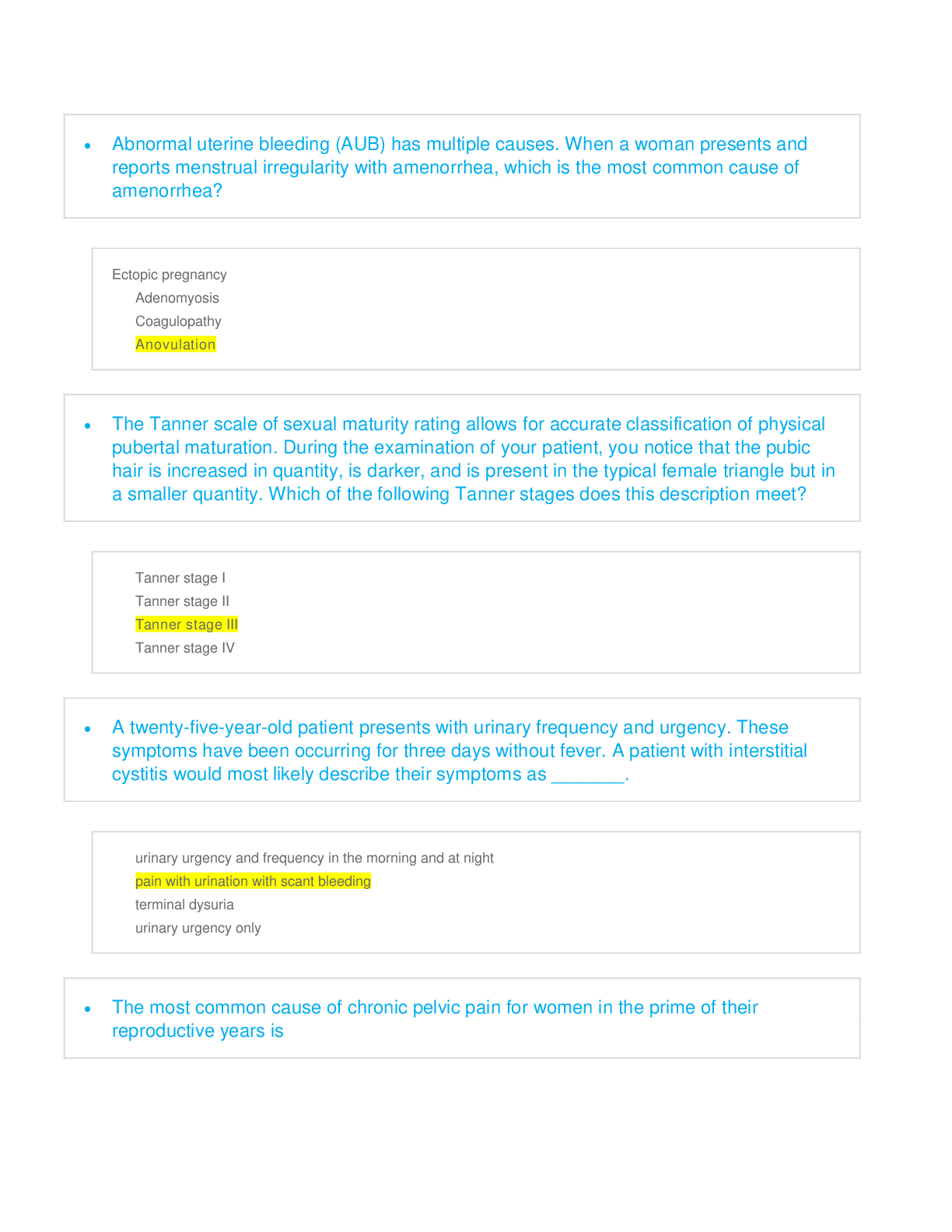
Reviews( 0 )
Document information
Connected school, study & course
About the document
Uploaded On
Oct 26, 2019
Number of pages
41
Written in
Additional information
This document has been written for:
Uploaded
Oct 26, 2019
Downloads
0
Views
63

